 |
Our first Big Bus Ride through South America
from Chile through Paraguay, Brazil and Uruguay to Argentina,
October 2002
|
Our route from Santiago, Chile through Mendoza, Cordoba and Salta in Argentina, Asuncion in Paraguay, Iguazu Falls in Brazil, San Ignacio in Argentina, Posadas, Fray Bentos, Colonia and Montivideo in Uruguay to Buenos Aires, Argentina.
|
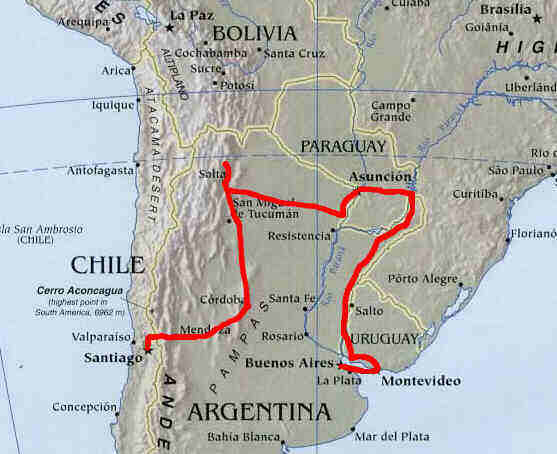
|
Santiago, Chile
|
Monday 7th October. We arrived in Santiago de Chile. After finding a hotel (Hostal Americano, special deal $20 at the airport hotel reservations desk), we straight away set about some serious sightseeing. The metro station is just down the road from the Hostal Americano, so we got the metro to the main square, Plaza de Armas, and had lunch in a café overlooking the square as the world strolled by. The square was full of street artists and strange statues. |
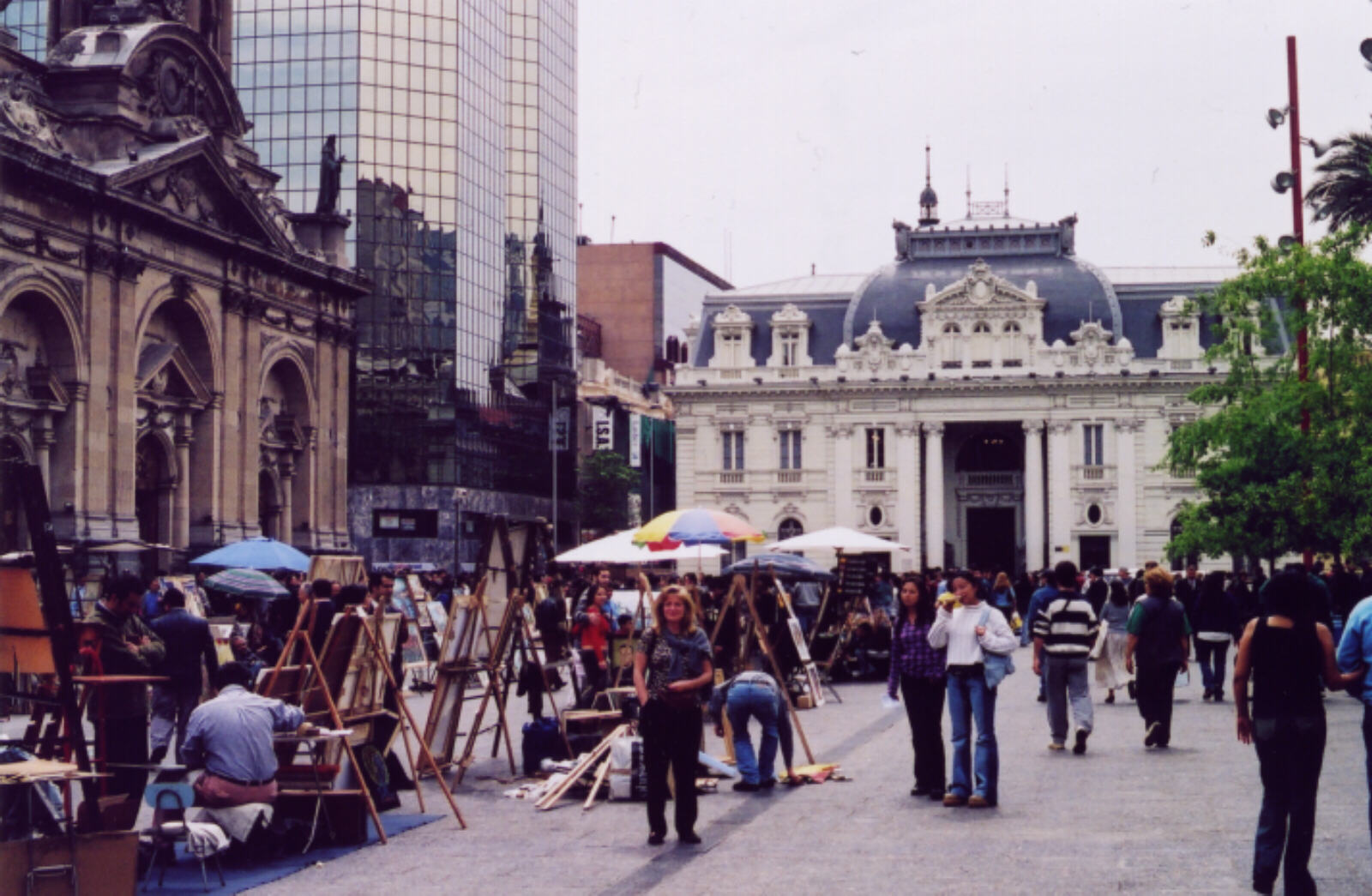
|
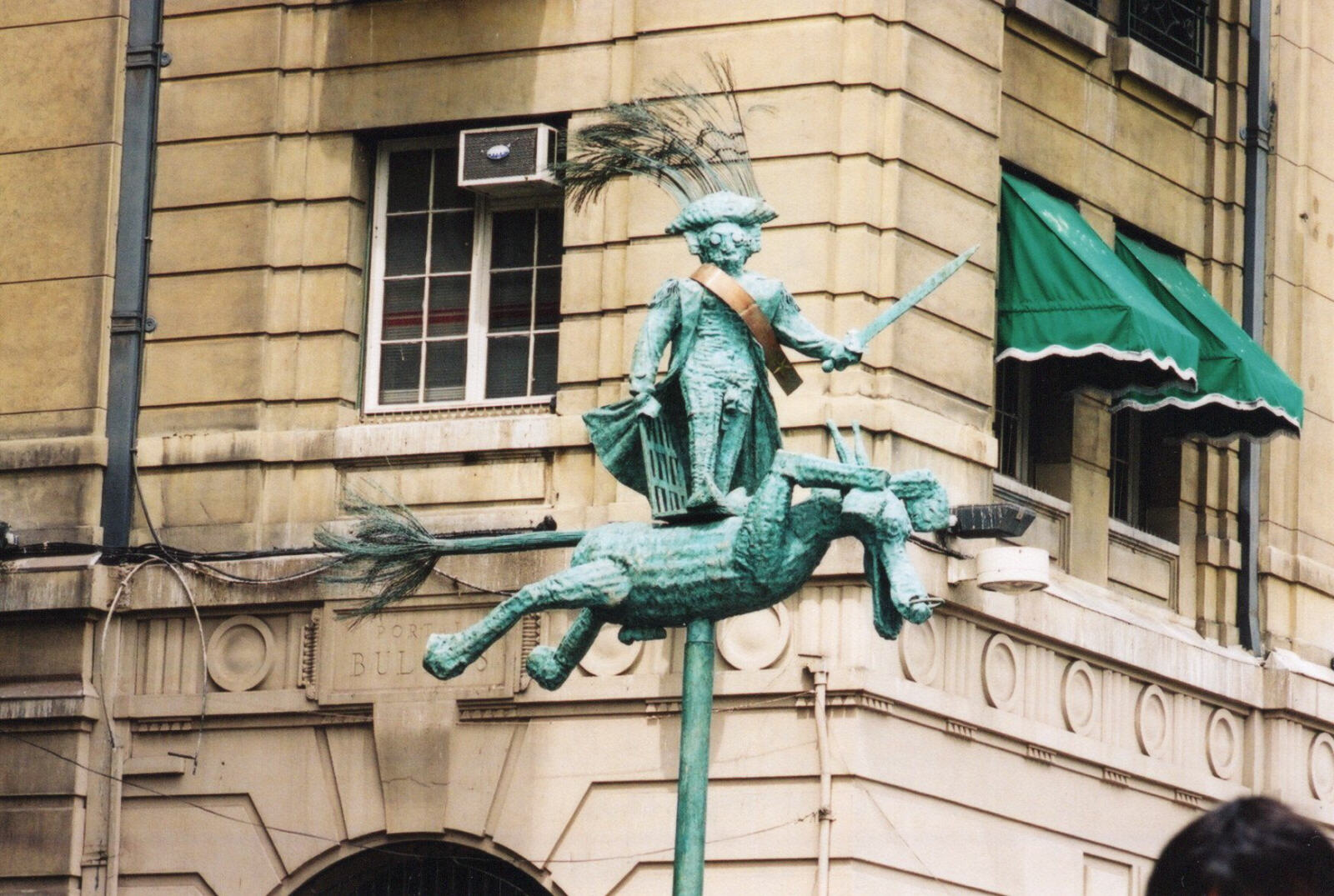
|
We walked down Puente, a pedestrianised shopping street, to the central market, which is a large wrought-iron structure made in Birmingham in 1872 and shipped here in bits. The market is half traditional market with meat, fish and fruit and veg stalls, and half trendy fish restaurants. We carried on walking round the shopping streets around the square, stopping only for ice cream, where we discovered 'dulce de leche' ice cream, amazingly rich and sweet, made from condensed milk; for the rest of the holiday we ate nothing else! Walking along Avenue Bernard O'Higgins, we branched off into Lastarria where there were several interesting-looking restaurants, then crossed the river into the Bellavista district where there were many more - no shortage of places to eat! First, though, we took the funicular railway up to the top of San Cristobal Hill for wonderful views of the city surrounded by the snow-capped Andes mountains lit by the setting sun. We finally settled for the restaurant 'R' back in Lastarria for a wonderful meal and a couple of 'Pisco Sours', a local drink like lemon sorbet with a huge kick. Finally we collapsed into bed in the Hostal, 44 hours after last getting up at home!
Tues 8th Oct. We got the metro to Los Leones, which is the business district and also has a good selection of restaurants. We sat out having coffee and cake at a café in Avenue el Boque Norte, then ended up in Holley Street, which is an almost Disney-style street of themed restaurants in renovated (or newly built) old houses. The competition is fierce and there are some excellent lunchtime deals. We got the bus back to Santa Lucia Hill, a pleasant park with a miniature fortress on the top in the centre of the city, with great views of Santiago spread out below, and the green hill reflected in the high rise buildings.
|
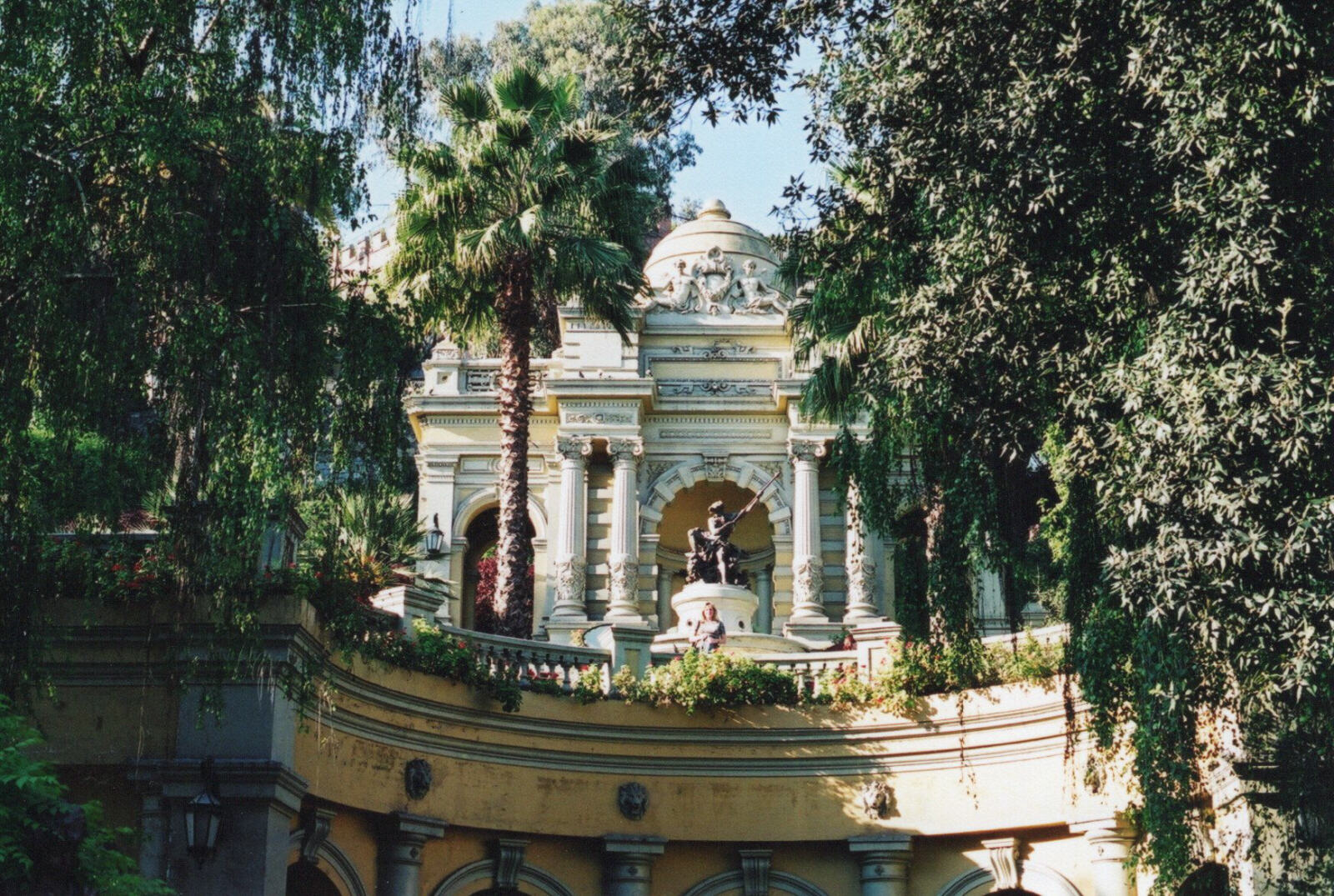
|
From there we walked around the downtown shopping district for a while then sat in the main square watching the world go by, and the mimes and story-tellers and 'moving statue' men and street artists. Finally we went back to restaurant 'R' for another brilliant meal - we are eating and drinking far too much!
Wed 9th Oct. We got the 9:30 bus from Los Heros bus station just down the road, across the Andes to Mendoza in Argentina. The pass through the mountains was impressive, with a zig-zagging road between snow-covered peaks. The mountainsides were steep, bare rocks with no plants at all and the road wound its way through snowdrifts and fast little streams where the snow was melting in the bright sunlight and a Condor was gliding high overhead. |
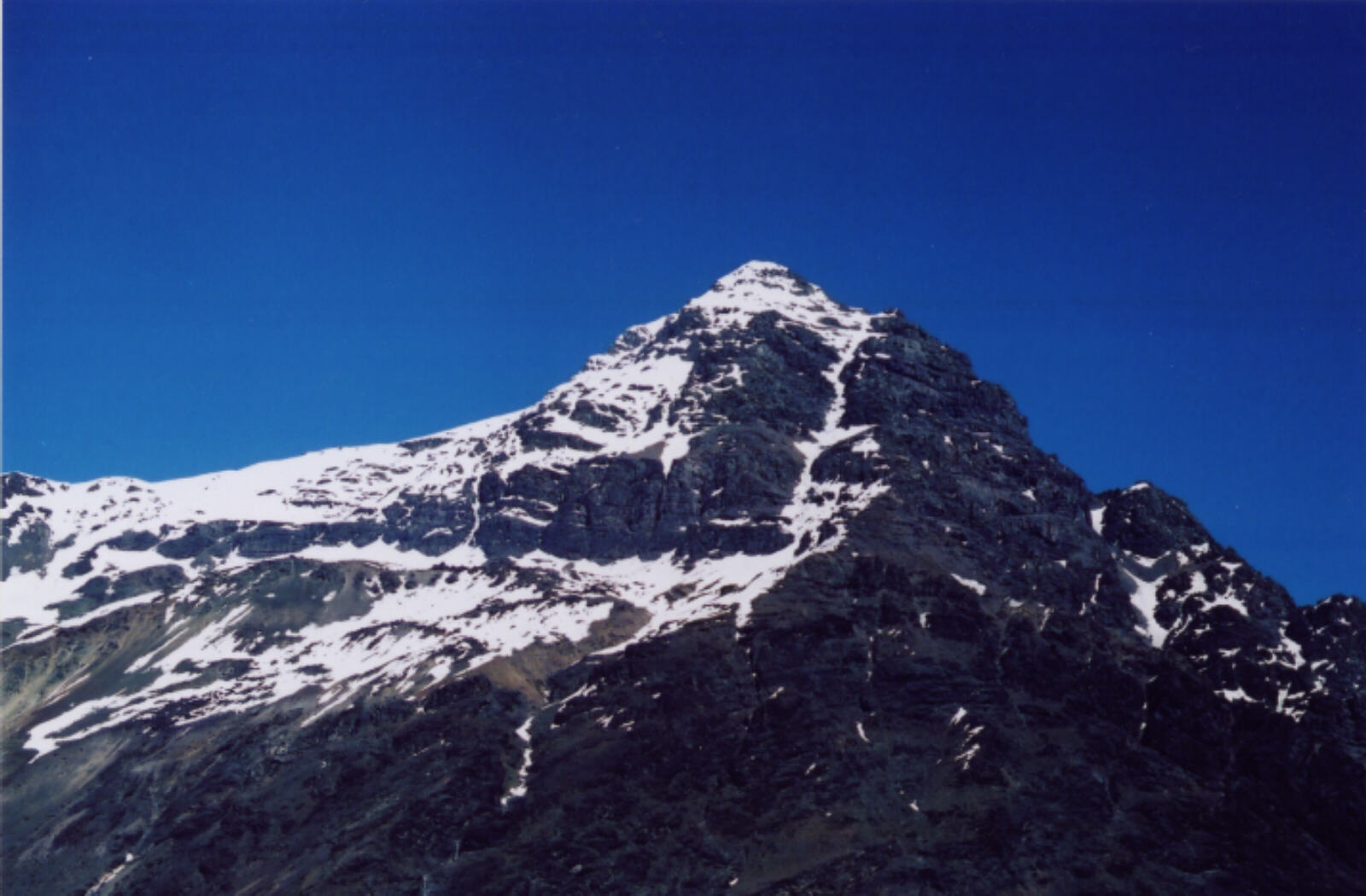
|
Mendoza, Argentina
|
The Ahumada-line bus was very comfortable with more leg-room that I've ever seen before - I really had to stretch my legs out to touch the seat in front. The conductor brought round coffee, tea and cold drinks from time to time and he completed all the paperwork for us so we breezed through the border. In Mendoza we discovered that Argentina is even better value than Chile. The taxi from the bus station to the centre of town was US$1, we found a pleasant, slightly run-down hotel right in the centre called the Rincon Vasco, where we got a 4-bed room (ensuite, TV, balcony) for 60 pesos (US$16). Then, after walking round town for a while and stopping for a beer, we had an excellent meal at "Mendoza's finest Italian Restaurant" La Marchigiana ($13 for two, 2 courses plus wine). We collapsed into bed again unaccountably exhausted after an easy day. Or maybe it was the wine.
Thurs 10th Oct. The wineries do not open to visitors on Thursdays, so unfortunately we couldn't go on the tour to try a little sampling of Argentine wine. Instead, we had a day at leisure in Mendoza, with shopping, a trolley-bus ride and plenty more eating and drinking.
Fri 11th Oct. We caught the 9 o'clock bus for the 10-hour (about 600km) trip through open prairie and scrubland to Cordoba. The T.A.C. line bus, although it was comfortable and we had a panoramic view from the front seat upstairs, wasn't as quick and efficient as the Ahumada one. We kept stopping to let people on and off and at one point there were several people standing (but no chickens). |
Cordoba, Argentina
|
We arrived in Cordoba but one of our bags didn't; it had been in the overhead rack and somewhere along the way somebody had taken it without us noticing. We attempted to report it to the police and although they were very helpful we didn't get far because the interpreter was not there, so we agreed they would ring us at the hotel and we would come back when he arrived. We checked into a hotel that the police recommended for us (Hotel Filipe II, great value at 60 pesos), and had just gone down the street and ordered a beer at a café when a group of policeman came up. One introduced himself - he was the interpreter - and we cancelled the beer and departed in a police car, to the great interest of the other customers. The police interpreter and inspectors were even more friendly and helpful and we made out our statements back at the police station, then they gave us a lift back to the same café where we ordered the same beers, while the same other customers feigned disinterest. We finally ate at midnight, just about the time that Argentinian cities get going.
Sat 12th Oct. A day at leisure in Cordoba, walking about, looking at the old architecture in Plaza San Martin and Independencia Street, listening to musicians in the square, shopping, keeping clear of a small anti-American political demonstration and, of course, eating and drinking. In the evening we had a Parilla - a barbecue of steak and other meats, with an all-you-can-eat starter and salad bar. Delicious! |
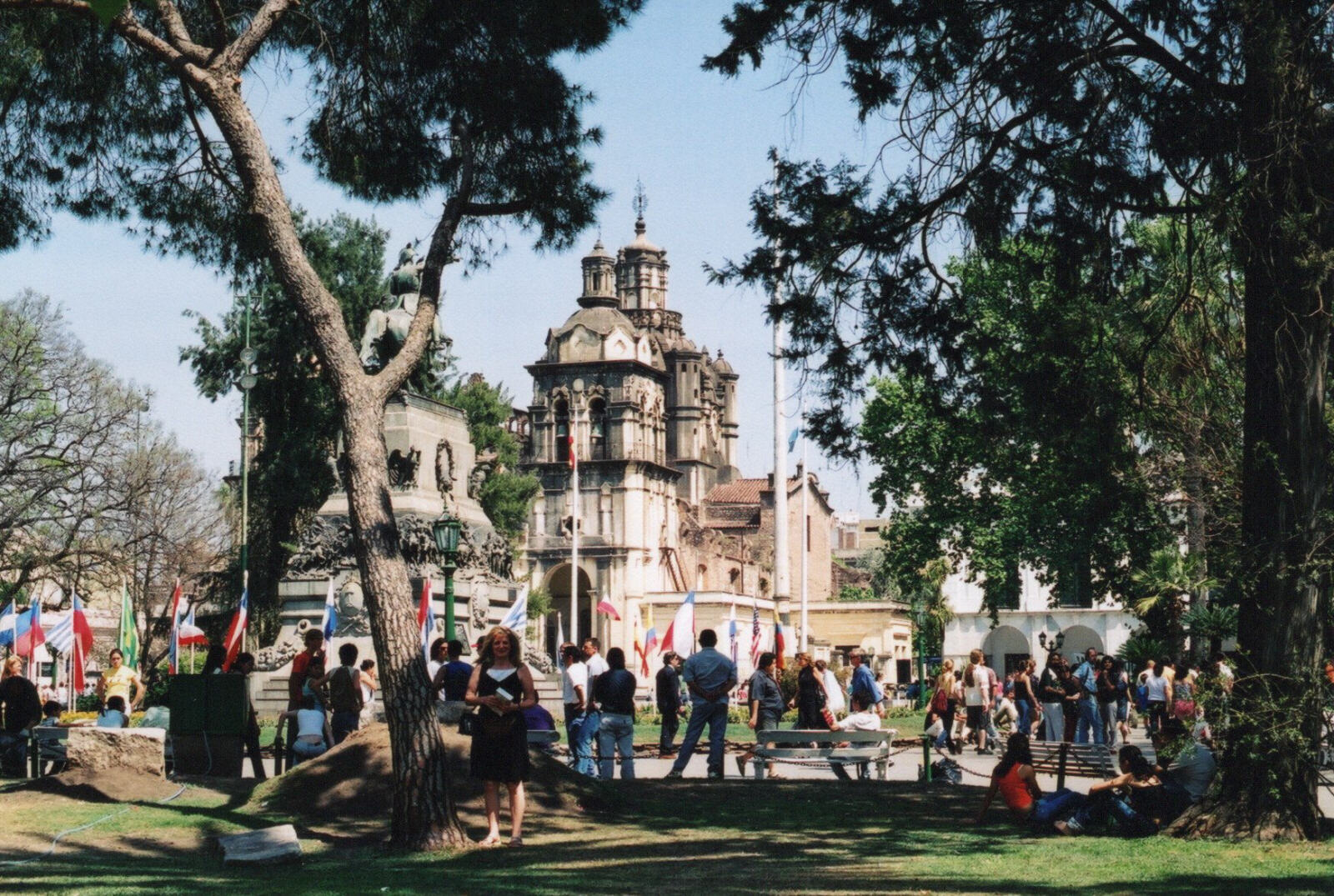
|
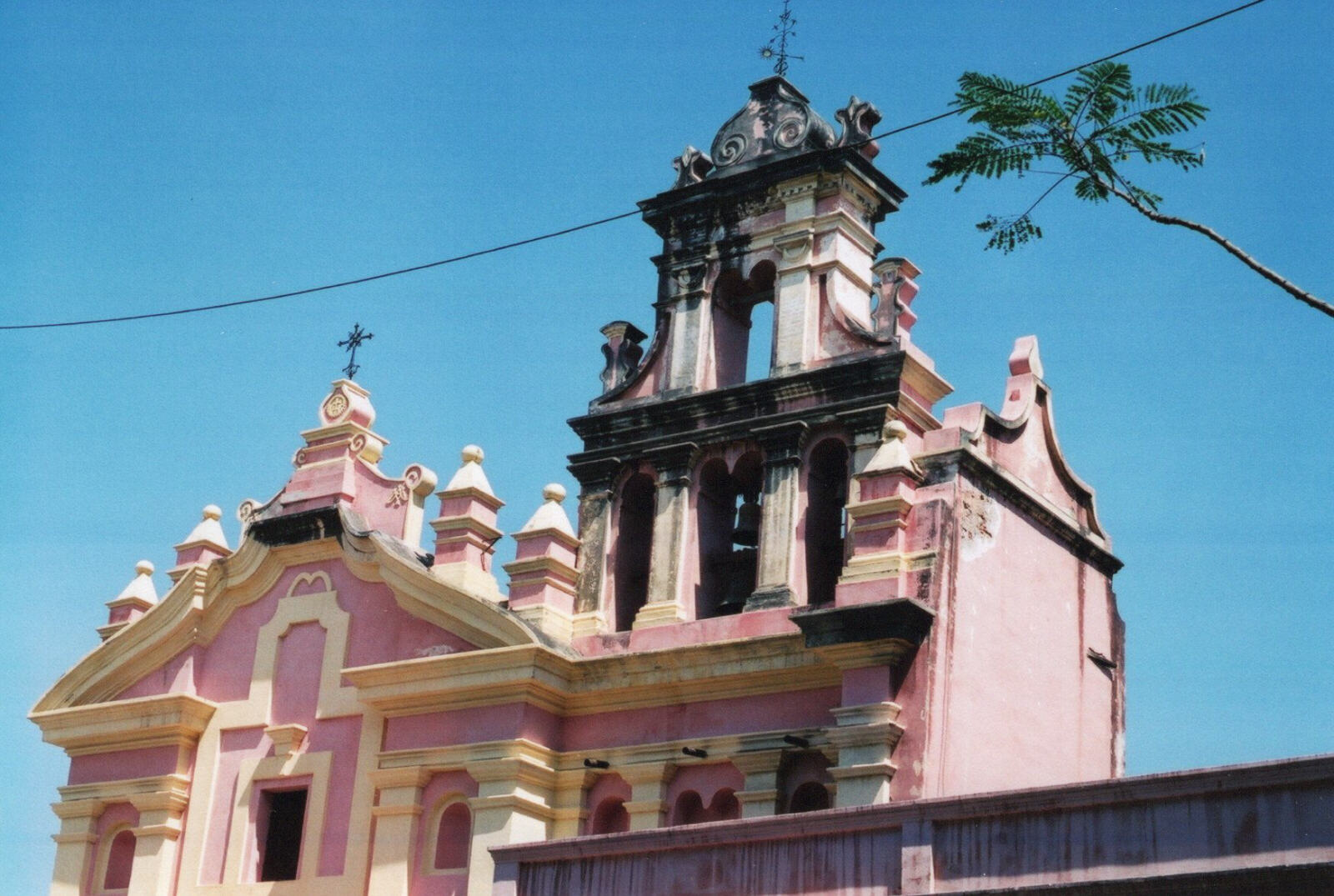
|
Sun 13th Oct. We went to Alta Gracia, about an hour away by local bus. Alta Gracia is a pleasant, historic town but, being Sunday, it was shut! There was a small craft market in the main square which we just managed to look round before they packed it away, then we had the town to ourselves. Alta Gracia used to be a summer retreat for people to escape the heat of Cordoba, but it was pretty hot here too, so after a short walk around we had a drink in a café then caught the bus back. Back in Cordoba we waited till evening when the temperature returned to bearable, then walked around for a while before returning to the Parilla for a meal.
Mon 14th Oct. We caught the 9am bus to Salta in north-west Argentina, about 800km/500 miles. The Andesmar line bus was very well organised, with a packed lunch at lunchtime, coffee and biscuits in the afternoon and three movies. During a couple of 5-minute stopovers the conductor swept out the floor, cleared away the rubbish and sprayed air freshener over the bus. There were two drivers so we didn't have to have lengthy stops, but it was a long way and still took 13 hours so it was 10pm when we arrived. |
Salta, Argentina
|
In Salta we got a taxi from the bus station to the central square and immediately spotted the Colonial hotel, a slightly faded old style hotel where we got a room for only 50 pesos (UK£5, US$7.50) with a little wrought-iron balcony overlooking the street. We had a late dinner of beer and a sandwich at a café on the corner of the square.
Tues 15th Oct. Salta has a great feel to it, lively and interesting, and it's the best place we've visited so far. We spent the day sightseeing around the city, and up the cable-car to the top of the hill overlooking it. There are several museums in old colonial houses which charge a token 1 peso to go in, such as the 18th-century Cabildo Historico museum on Plaza 9th of July, with its unusual weather vane (first picture) and the colonial-style house of Arias Rengel, constructed in the 1740s, on Florida street (second picture). Also several ornate old churches such as the San Fransisco Church (third picture), as well as lively squares and shopping streets. Even at siesta time it only slowed down a bit, not shutting up completely like the other towns we've been to. |
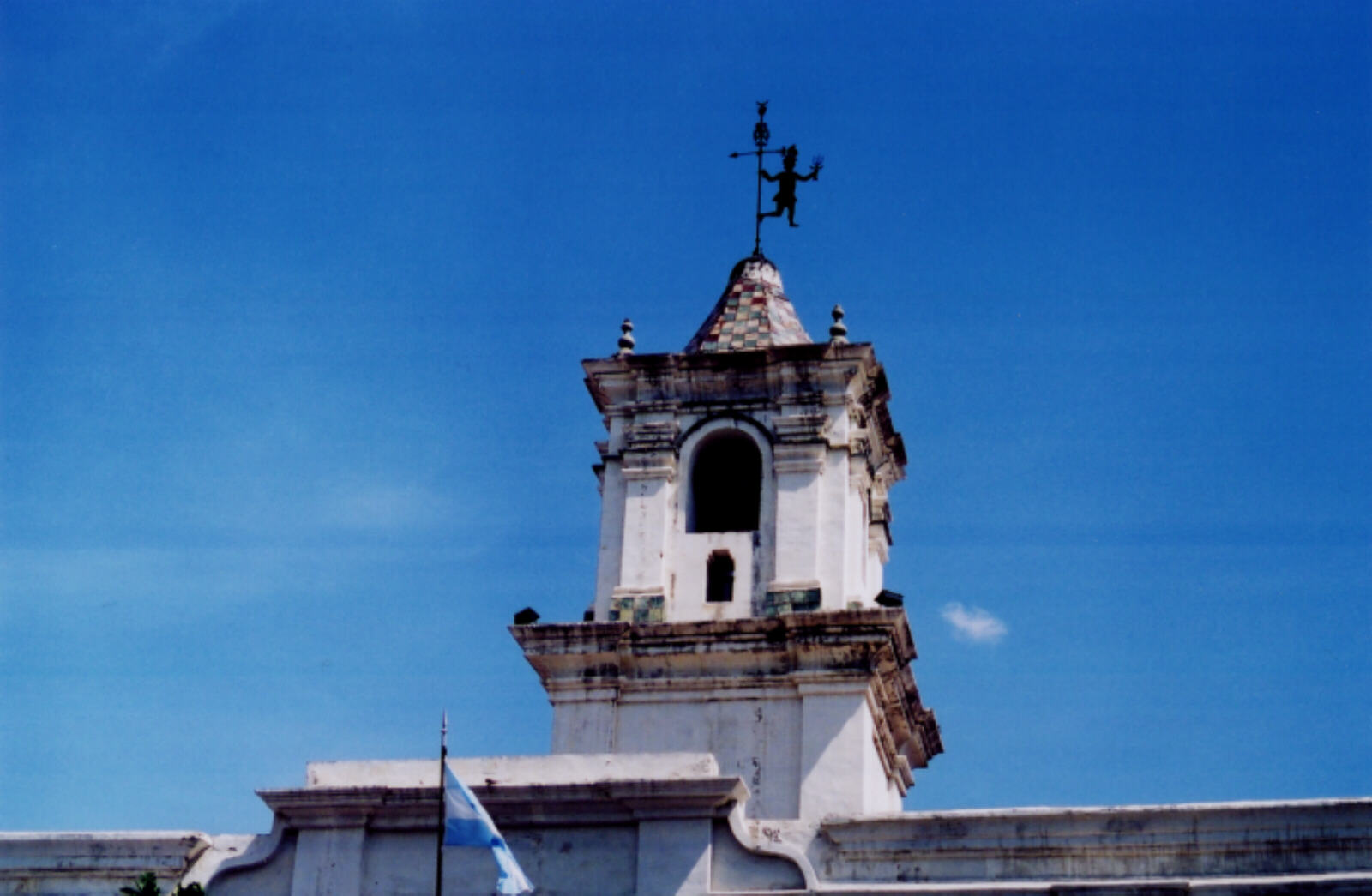
|
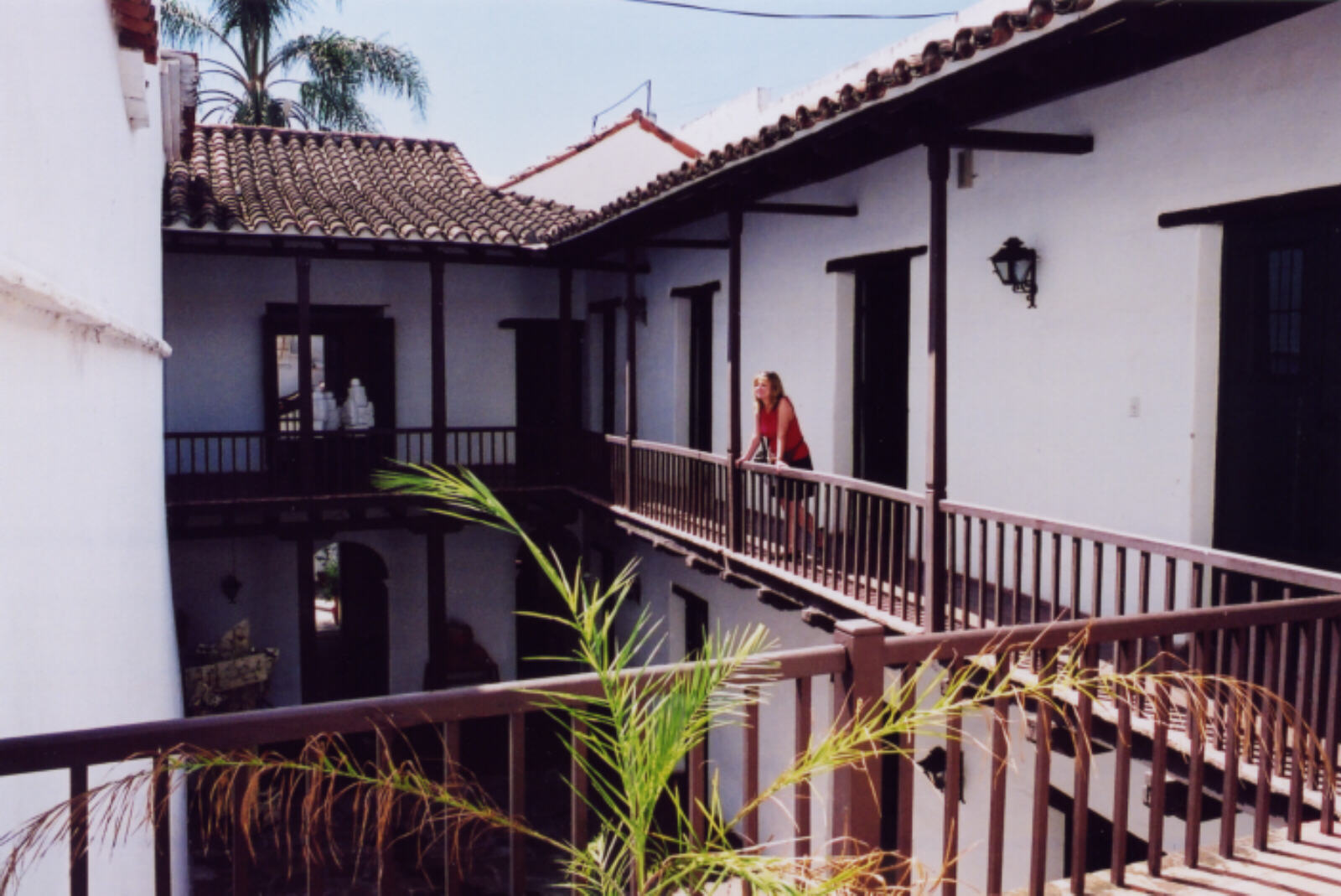
|
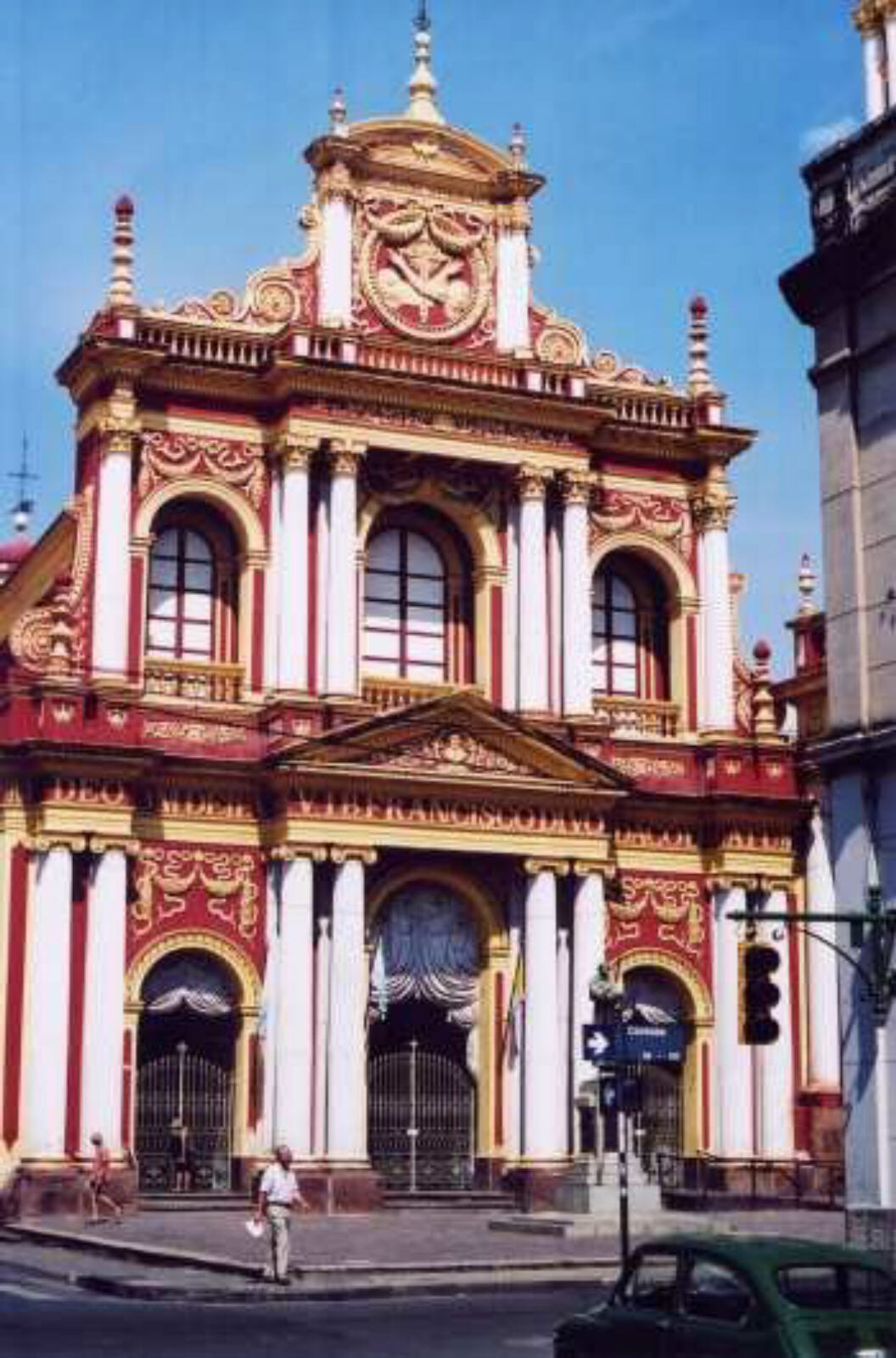
|
Wed 16th Oct. We tried to go on an organised tour to the picturesque valley of Humahuaca in the Andes today but the weather defeated us. Up to now it has been pleasantly warm to really hot, but during the night and into the morning it poured with rain and the temperature plummeted. At first we regarded this as a minor inconvenience, but as the tour minibus drove up the road we started meeting drivers coming back the other way telling us that the road had been blocked by a flash flood. The mountains around here are really crumbly and flaky and any rain washes copious quantities of debris down into the valley where the road and former railway run alongside a wide river bed. The railway used to lead up to Bolivia, but they abandoned the task of trying to maintain it 20 years ago, and now the rails hang crazily in mid-air over gaping holes, or disappear into mounds of shale. We drove as far as the blocked road and sure enough it was impassible, so our driver proceeded to try to find other things to entertain us. We stopped at a llama farm and fed the llamas with tasty twigs from nearby trees. The llamas were soft and wooly, even though they were still sodden from the rain. Most of the herd were quite nervous, but one became very bold and snatched the twigs from our hands. As we left the farm the owner told us about the best restaurant in Salta, run by her nephew, where we could try llama steaks! We visited a little town with a pretty church and drove back to Salta on a different winding mountain road, but it wasn't the trip we'd wanted and the tour agent was very good and gave everyone their money back. |
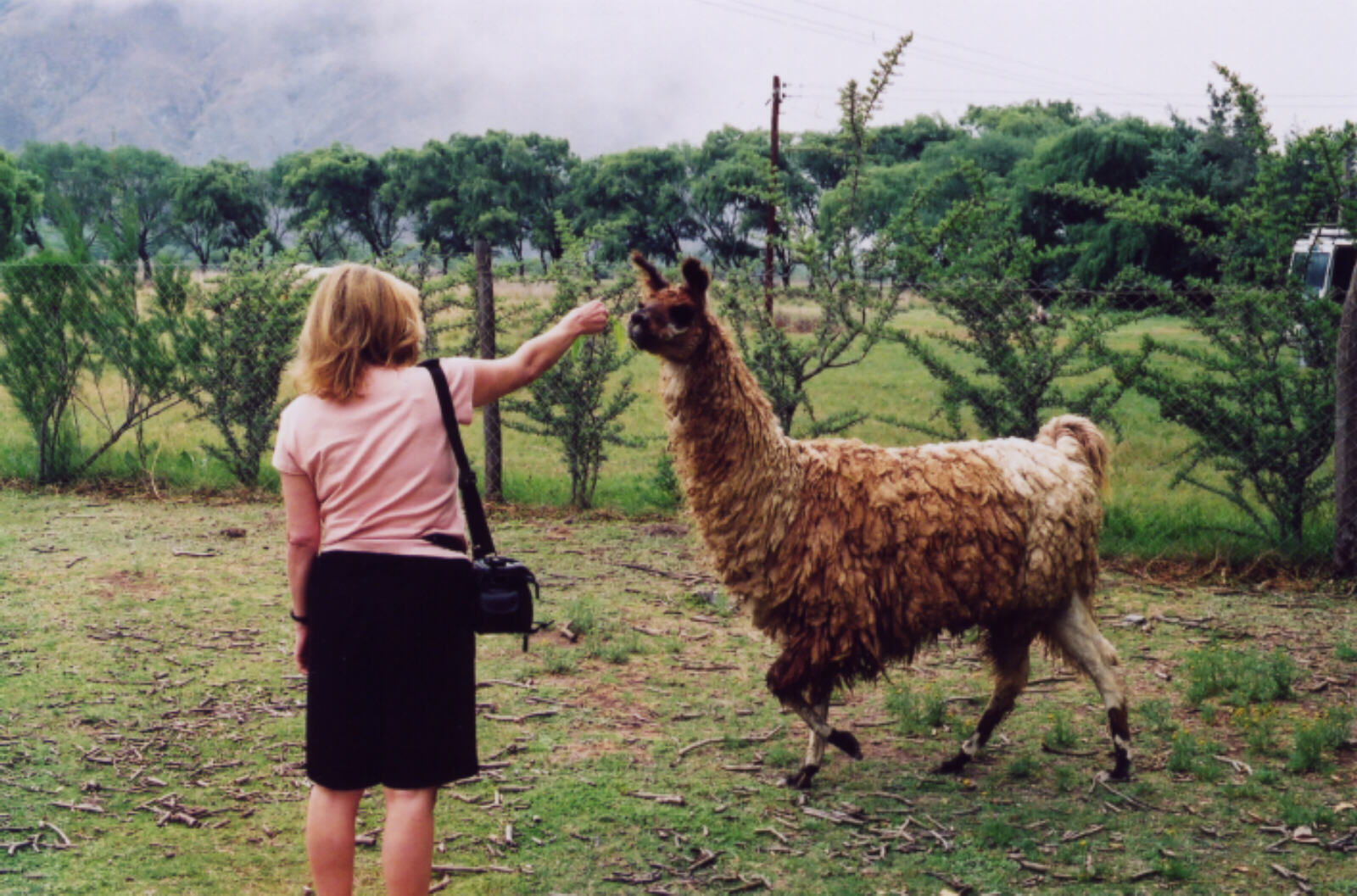
|
After an unexpectedly restful afternoon (the tour hadn't been due back until 9pm) we went to José Balcarce, the restaurant that the llama farm lady recommended. It was wonderful; very stylish and clearly frequented by the elite (i.e. rich) of Salta. The chef, dressed in black with a big black chef's hat, came out and described the menu to us. We received complimentary glasses of champagne with our starters - carpaccio of llama and a Caesar salad. Then for main courses we had a Chateaubriand and fillet of llama - both delicious, tender meat perfectly cooked, with crisp vegetables and a little pastry case of curried potatoes, washed down with a pleasant local Malbec red wine and mineral water. We finished with a couple of beautifully decorated sweets, and the whole meal cost 56 pesos (US$16, UK£11). Fabulous.
Thurs 17th Oct. Morning in Salta - breakfast at a café on the square, a walk through the market and visits to three of the city museums, where the main attraction is the interesting old buildings that house them; 18th century houses with leafy interior courtyards and wooden galleries. In the afternoon we caught the overnight Nueva Estrella line bus across miles of endless scrubland to Clorinda on the Paraguay border. It was quite comfortable and we got a reasonable amount of sleep. |
Asuncion, Paraguay
|
Fri 18th Oct. We bought a sandwich for breakfast at one of the stops along the way, had a coffee from the coffee 'tap' on the bus, and arrived at Clorinda, the border town, in quite good shape. Getting through the border was a bit fiddly - there are apparently buses that go directly from Clorinda to Asuncion but we were whisked away in a taxi to the border, completed the formalities very quickly at two adjacent windows (out of Argentina and into Paraguay) then found a minibus for the trip into Asuncion (at 30 pence/50 cents, a lot cheaper than the taxis). Asuncion is a bit run down and very busy, with traffic jams in the sprawling suburbs before you eventually get through to the centre. We drove around in a taxi checking out hotels and settled on the Plaza, on Plaza Uruguaya in a fairly central location, quite nice with a/c and fridge for $21 including breakfast. At the laundry next door we had a huge pile of laundry done for $6, and it was ready that afternoon. We had lunch at Café Literario, a stylish café that doubles as a bookshop. We would have browsed, but not surprisingly all the books were in Spanish. |
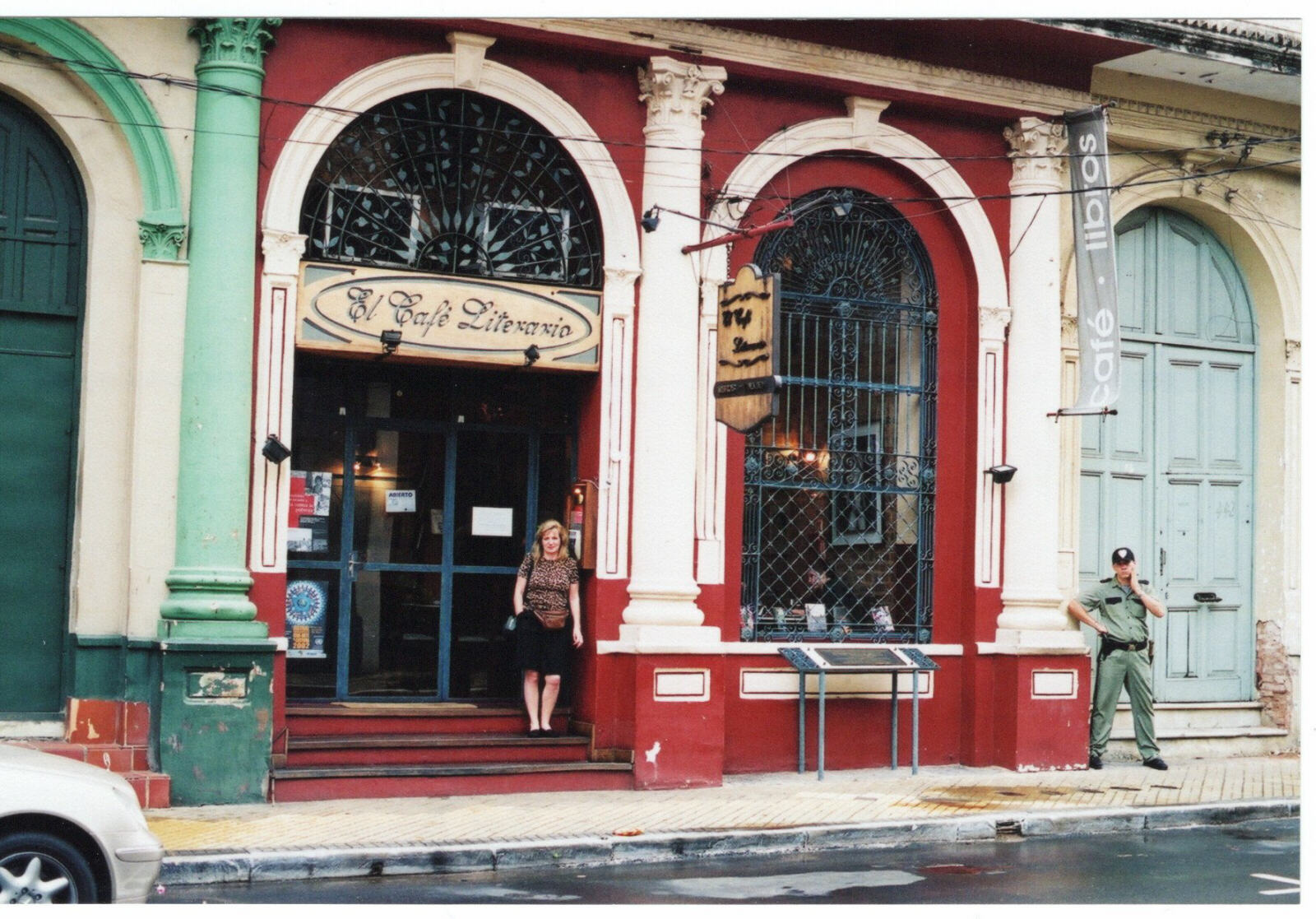
|
Then after a walking tour round the centre of Asuncion, we decided to go out to the Yacht and Golf Club, a top-end hotel, for a drink and a look at the yachts. This turned out to be a bit of a disaster - it was miles outside the town and the taxi driver tried to charge us a 50% surcharge (which actually only applies after 10pm), so we had an argument and didn't pay it. Then, because it was after dark, the yachts were shut - the 'beach' on the river Paraguay is closed at night. So we had a drink and returned to town. The first couple of restaurants/bars that we tried were charging an entrance fee because they had entertainment on, but we didn't feel up to it so we finally ended up back at the Café Literario.
Sat 19th Oct. Woke up to another tropical downpour, which rather dampened our plans for walking about taking photos. The Plaza hotel breakfast turned out to be a surprisingly good buffet, so we lingered over it for a while, then went for a look round the shops in the rain. Paraguay closes at midday on Saturday, so we went to the Bar San Roque, actually a very smart restaurant, for a very nice lunch: a bottle of champagne, fish soup, beef stroganoff, tenderloin steak with eggs and onions, rice pudding, for $20. After resting for a bit to recover from this, the rain had eased off and we went sightseeing to the railway station, the president's palace, a museum and the river front. In the 1830s President Francia ordered that anyone observed gazing at his palace should be shot in the act, but it is reputed to be safer now. |
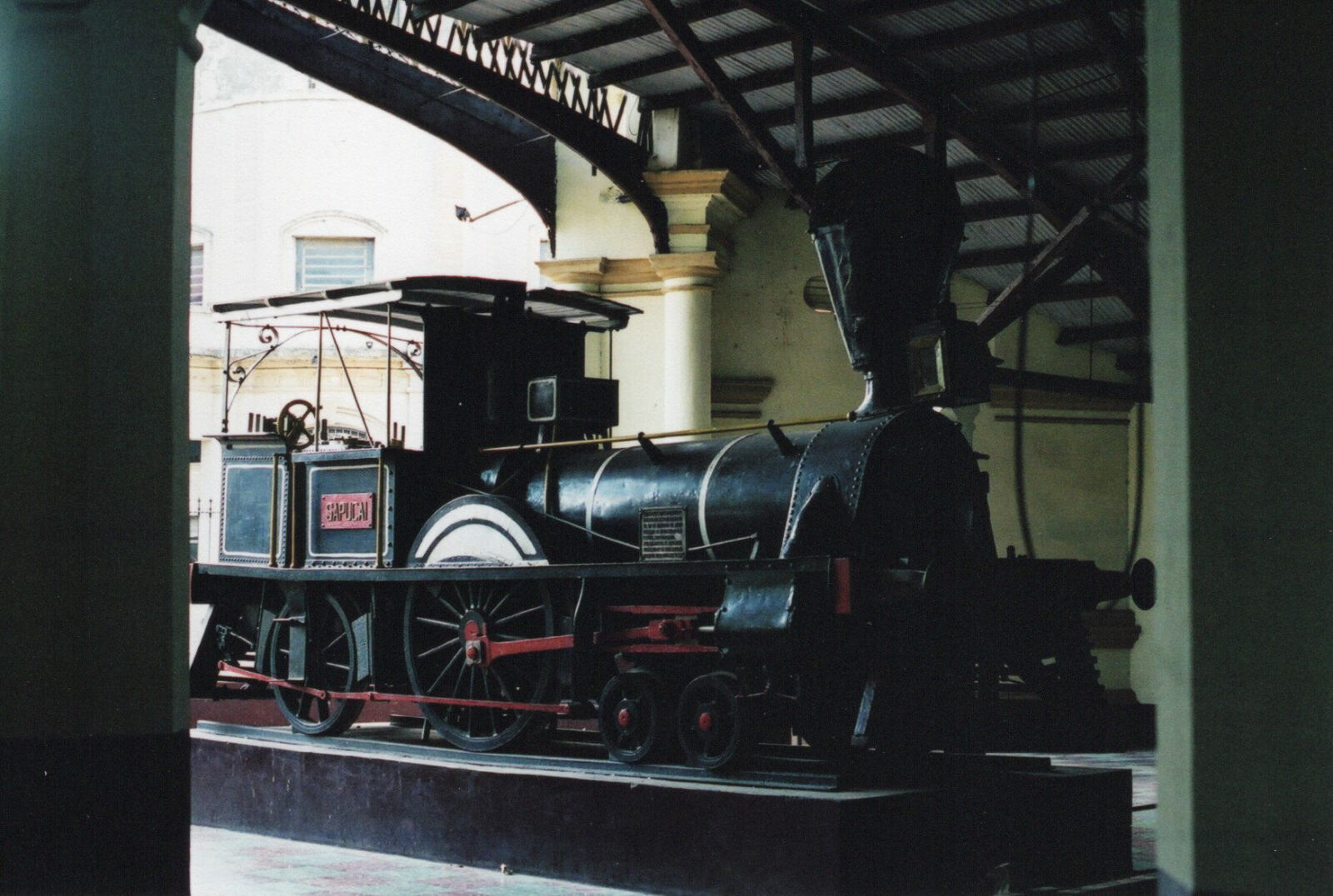
|
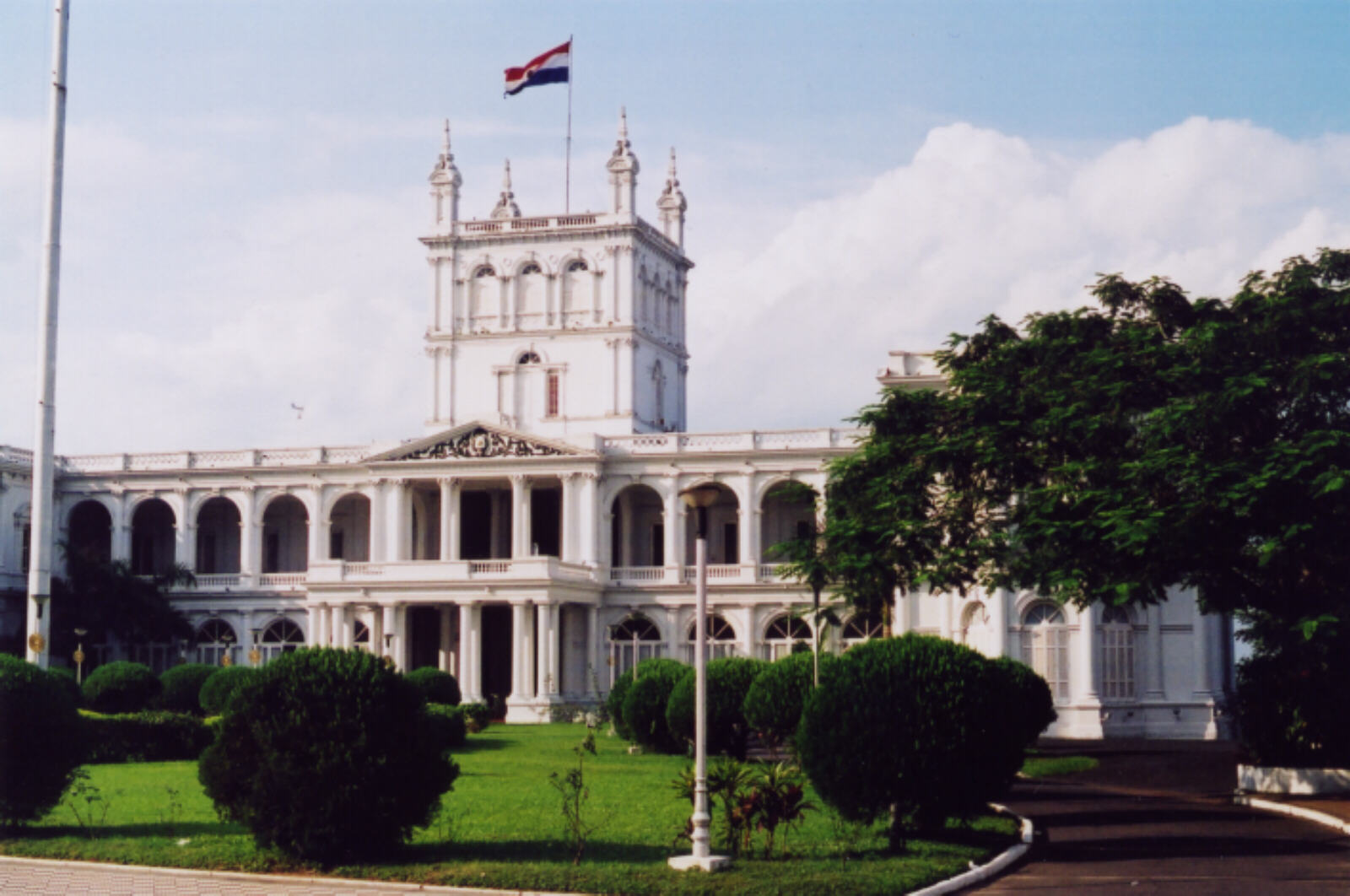
|
Foz do Iguacu, Brazil
|
Sun 20th Oct. We got the 7:30 bus for the 5-hour ride across the rolling farmland of southern Paraguay to Cuidad del Este and across the border to Foz do Iguacu in Brazil. We asked the taxi driver at the bus station for his recommendation for a downtown hotel and he took us to the centrally located San Rafael Hotel which was very good, at 84 reals (UK£17, US$25).
It was 2pm and we went straight for a tour of the falls - the magnificent Iguazu waterfall which is the main reason anyone comes here. We entered the national park (8 reals) and after a short drive stopped to do the Macuco jungle trail and boat trip. This was expensive (US$33 each) but worth it. Firstly, as we were waiting to board the electric car for the first part of the jungle trip, the place was swarming with beautifully-coloured butterflies. The 'safari' was quite short - a 15-minute electric car ride and a 600-metre walk, but we saw iguanas, snakes and a toucan (but not the monkeys and jaguars that also inhabit the park) as well as a riot of vegetation and a fair number of biting insects. The boat ride was fantastic - we went upriver against a strong current for a while and soon had some magnificent views of the waterfall, which is absolutely huge. As well as being high and loud it is also wide - there are several groups of waterfalls stretching along the river and at the end a massive cloud of spray and steam where the biggest part of the cataract plunges down into the river below. After pausing for photos we put cameras and everything else into plastic bags that they provided, and raced upstream into the spray - it was a wild ride, the river was racing and the spray and white water drenched us - it was great! |

|
We drove further into the park and then walked along the walkways down the riverside cliffs which give ever-changing spectacular views of the falls, as well as entertaining wildlife such as lizards and Coatis (Ko-watees - cat-sized, anteater-shaped, raccoon-related animals) which came up and sniffed us and wandered on; and an endless chain of leaf-cutter ants, each carrying their bit of leaf. Finally the walkway extended out into the river itself under one of the main falls, and we were drenched again. It was great! |
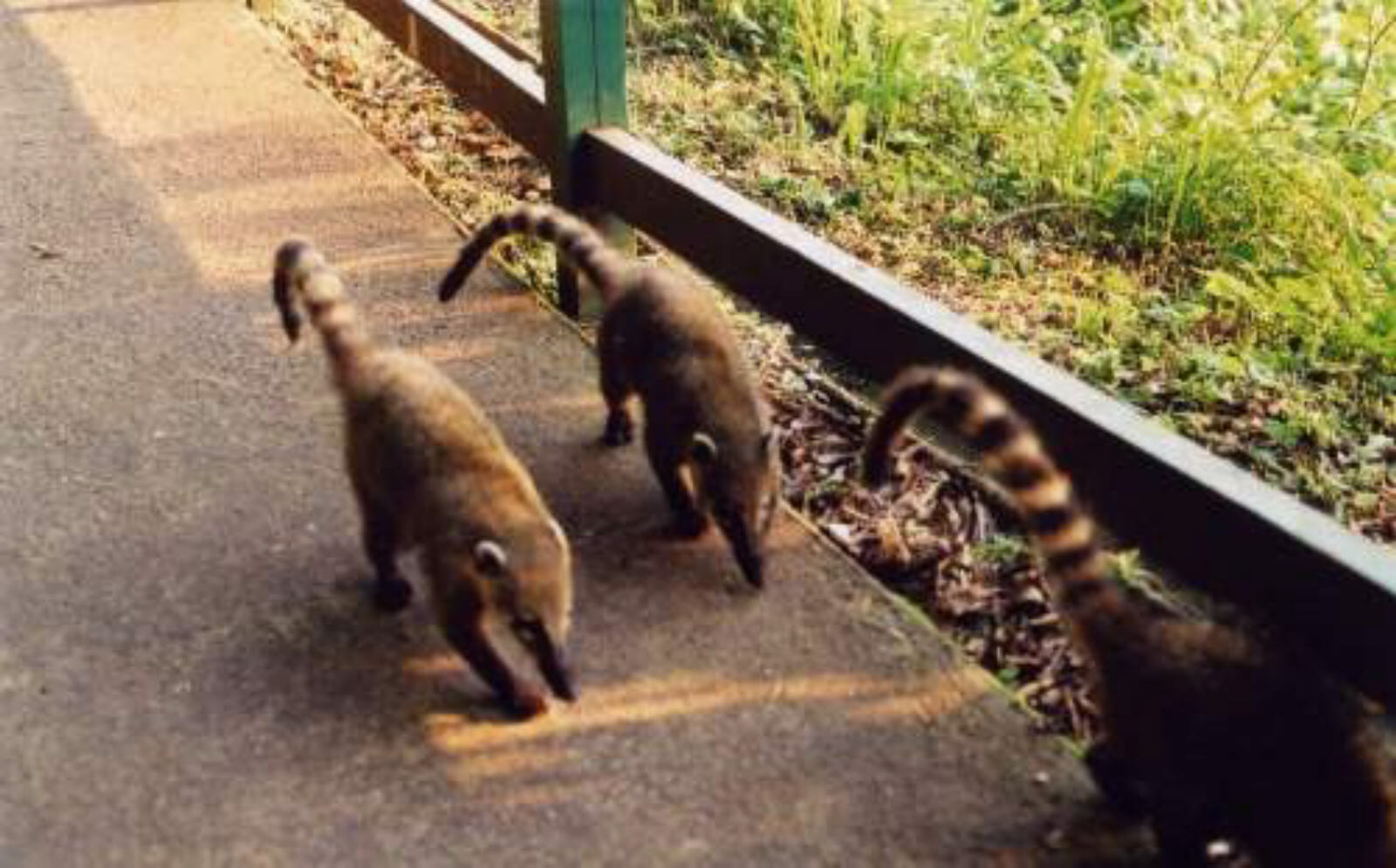
|
By now it was dusk and, having had enough excitement for one day, we had a pizza at Pizza Hut and retired.
Mon 21st Oct. We discovered last night that the falls are closed on Mondays! Or rather, I expect the falls keep going but the Brazilian park is closed, so it was fortuitous that we went yesterday. Sheila was a bit under the weather with a shivery flu bug (which wasn't helped by getting soaked yesterday) so we had a quiet day in Foz D'Iguazu, looking round the shops (which didn't take very long). We did manage to fit in a couple of meals, a nice sandwich and waffle at the Café de Paris, and an excellent dinner at Cantina Ricordi in a nice old-fashioned wooden building where the waiter was most friendly and attentive as he practised his English on us. |
Iguazu, Argentina
|
Tues 22nd Oct. This is the day we splash out on a bit of 5-star luxury. We got a taxi across to the Argentine side and checked into the Sheraton Hotel which has a spectacular view of the falls from all the rooms on one side. We had enquired about the cost at another Sheraton and at a travel agent and they all quoted in the $180-$200 range, but our hotel in Foz got us a deal for $145 which seemed very good. We could have just sat on our balcony looking at the falls for the rest of the day, but there are walks and boat rides to do. There aren't enough superlatives to describe the falls from the Argentine side. There are three different sorts of walkways, about two to three miles long in total, that go over, under and through the falls, giving you an endless succession of views of raging waterfalls, clouds of spray, rainbows, cliffs and jungle. We were enthralled. |
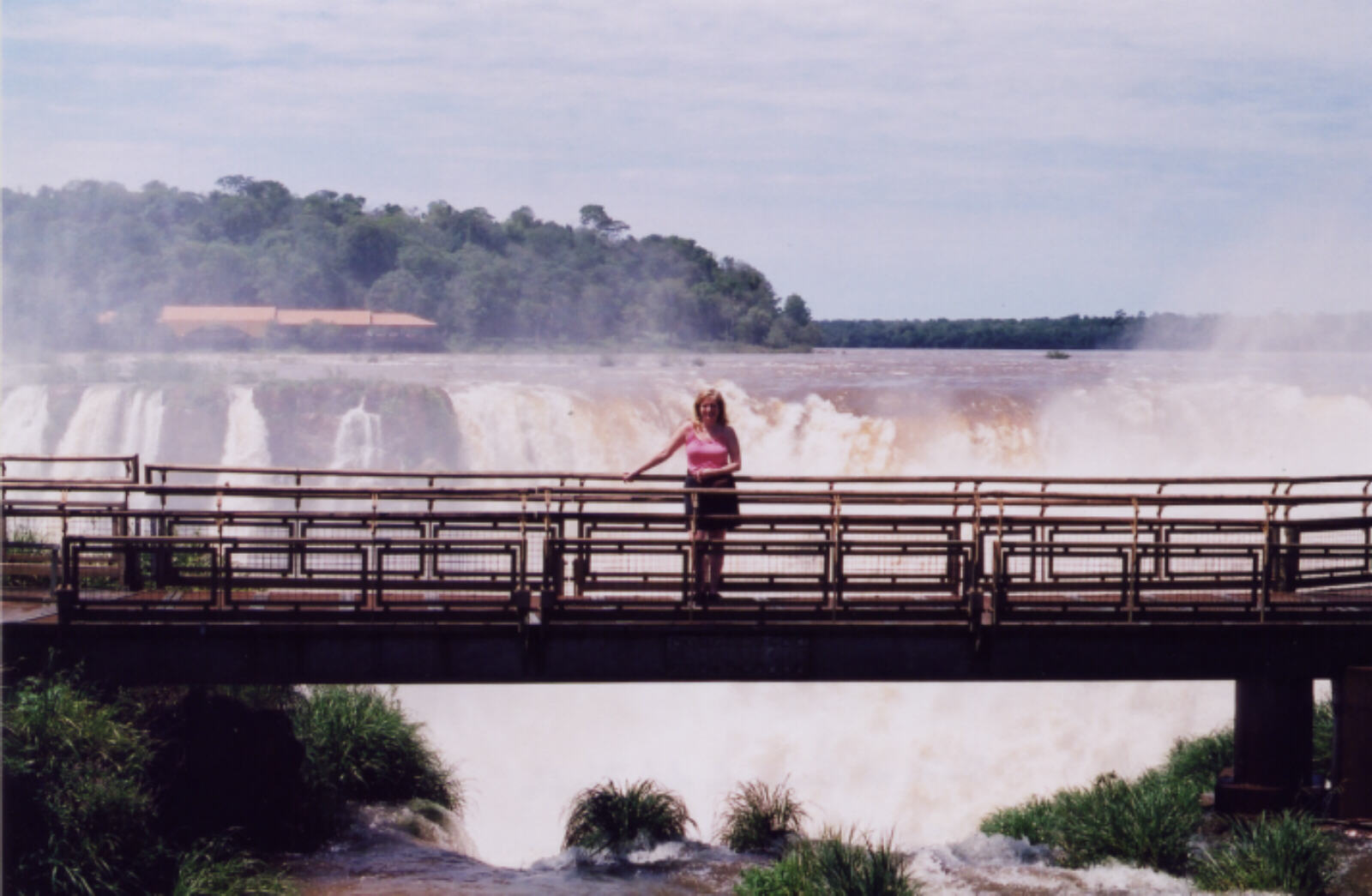
|
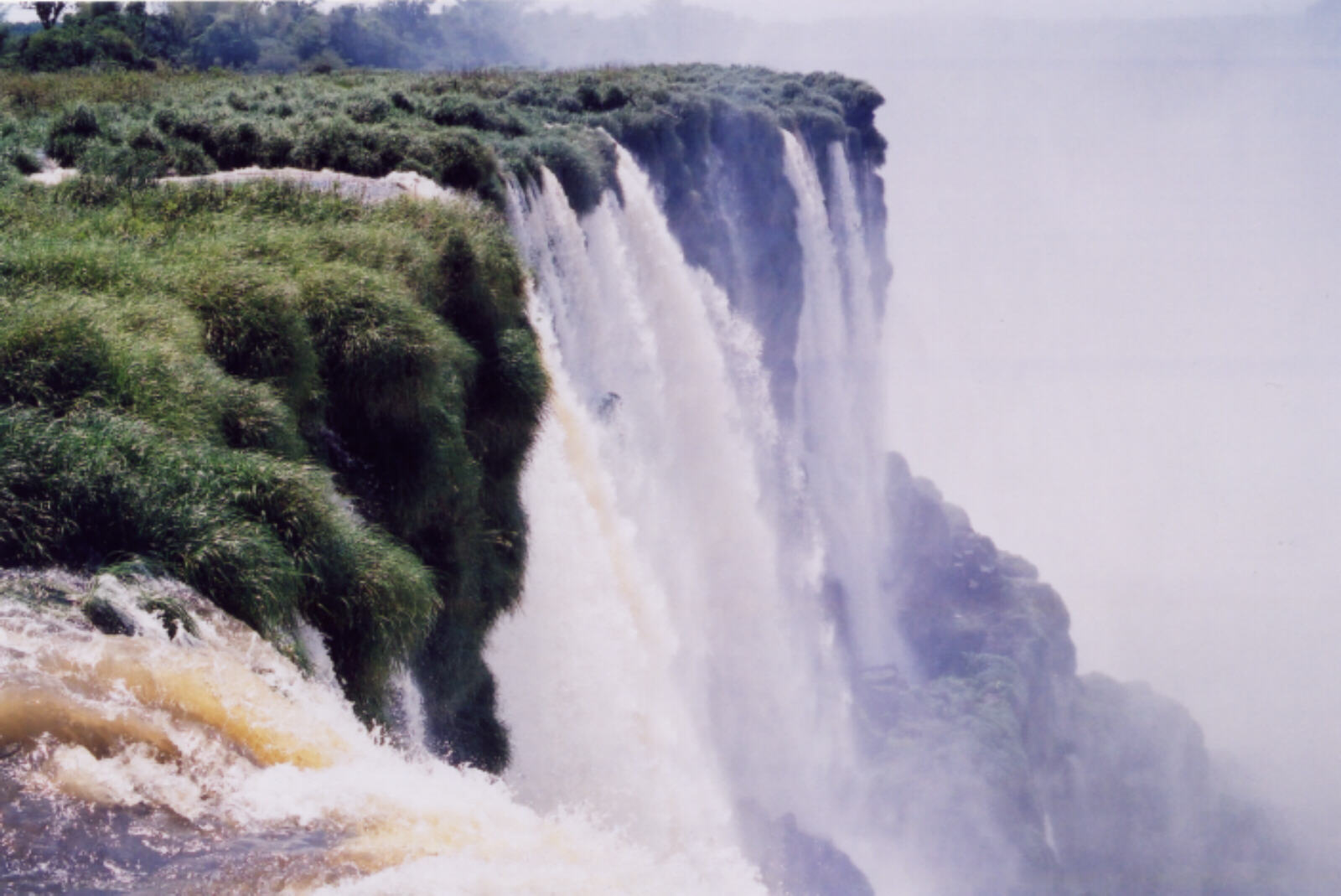
|
We also took a gentle boat ride between two of the walks, along one of the backwaters through the jungle and saw monkeys in the trees. Whereas the Brazilian side gives you a succession of great vistas, the Argentine side is a series of close-ups - in many places you stand just a couple of feet over where the water tips over the edge and crashes down into a boiling cloud of steam. We finished up at the end of the lower trail where the walkway extends out from the jungle into a pool right in front of one of the falls, and the hardy types who go right to the end (like Sheila) are drenched in a cloud of water with tremendous force. The falls are far bigger than Niagara or Victoria Falls and are one of the most spectacular things we've ever seen.
Wed 23rd Oct. We woke up at 5:45am, opened the curtains in our hotel room, and the falls were still there! After a big buffet breakfast and a relaxing morning we hired bikes and went for a jungle cycle ride. There were interesting monkeys, beautiful butterflies and swarms of really nasty mosquitoes. We couldn't stop, or clouds of the blighters would descend on us, so we kept going as fast as we could to the waterfall at the end of the trail, had a rapid look, and cycled back at top speed. |
San Ignacio, Argentina
|
We caught the 1:45 bus from the bus station in Puerto Iguazu for the 4-hour ride to San Ignacio, a little town in Missiones province with the ruins of a Jesuit Mission Station. The bus didn't go into town, it simply dropped us by the side of the main road and we walked up the road into town looking for a hotel. By the little main square we found the San Ignacio hotel and stayed in a nice wooden cabin for 35 pesos ($10). It's a quiet, out-of-the-way little town and not much was happening. Although it does cater for tourists there was an out-of-season feel and most of the restaurants were closed. We found a café open and had very tasty empanadas (like little Cornish pasties) and french fries and two big beers for 13 pesos ($4).
Thurs 24th Oct. After a nice breakfast at the hotel ($1 extra) we went to see the ruins of San Ignacio Mini Jesuit mission, built in the early 1700s, which are in a pleasant leafy enclosure in the centre of town. They are very impressive, with rows of quarters where the Guarani natives lived, a large central square and a big cathedral, cloisters and schoolrooms, library, etc. It is all built in sturdy stone with elaborate carved doorways. There is also an interesting 'interpretation centre' with a Guarani hut and other displays, including a room full of severe-looking Jesuits coming to civilise you! |
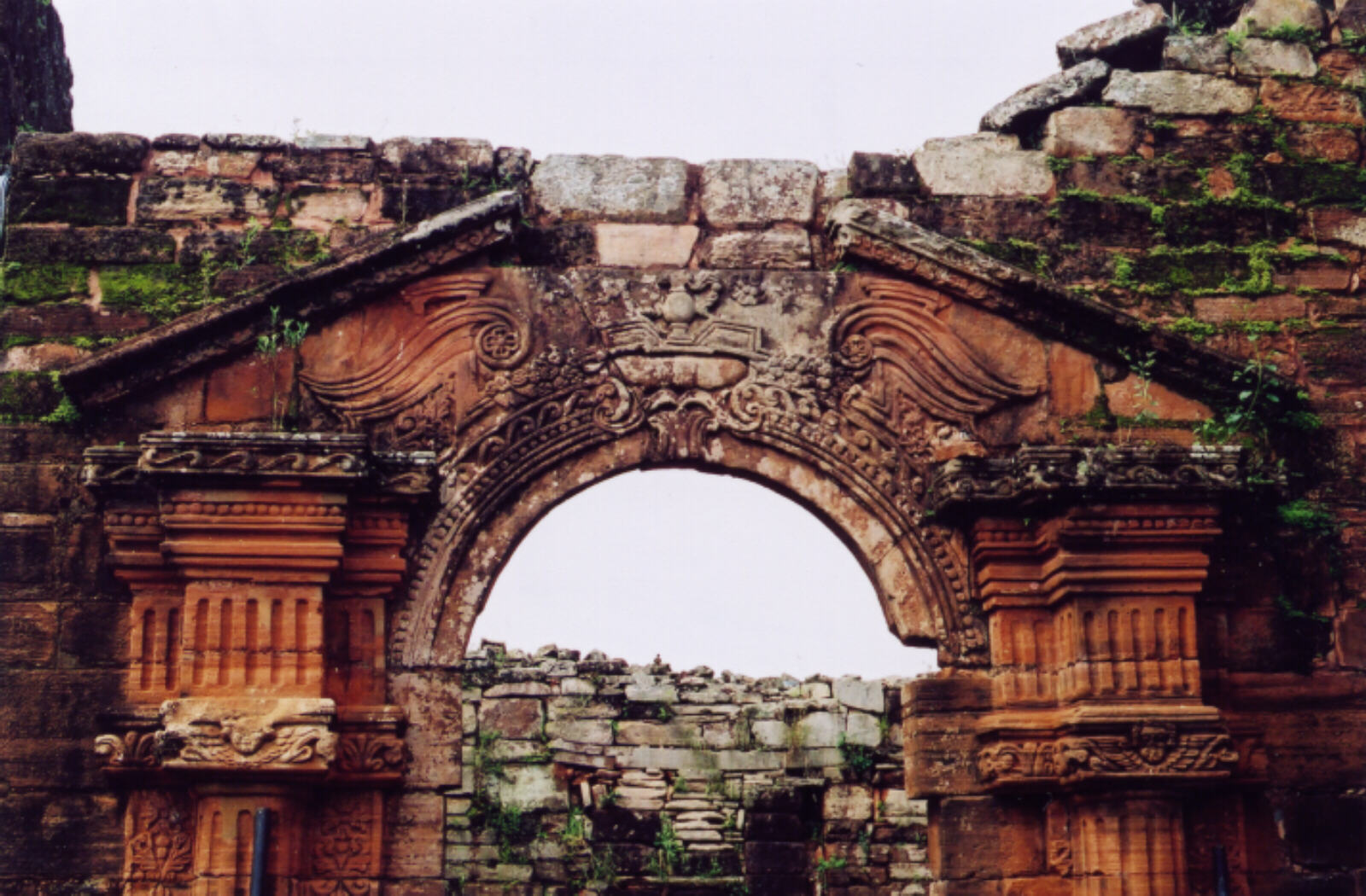
|
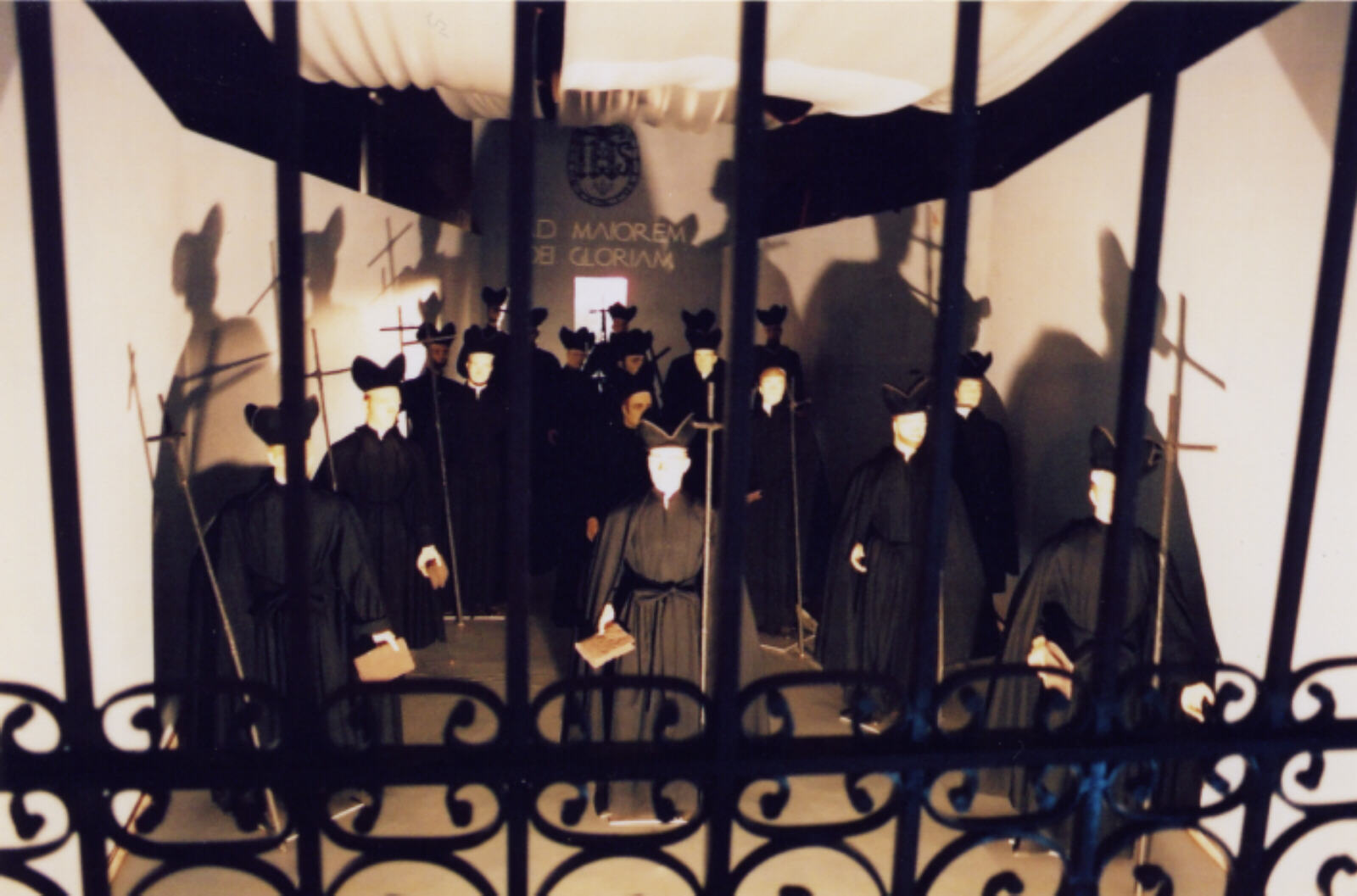
|
Posadas, Argentina
|
We got the local bus to Posadas (1 hour, very comfortable - there don't seem to be any 'chicken buses', even the local buses have reclining seats, etc) and I had a look round at the abandoned steam trains in the closed-down railway station and the paddle steamers in Posadas harbour that used to take the trains across the Parana river to Paraguay, while Sheila had a nap in the City Hotel. |
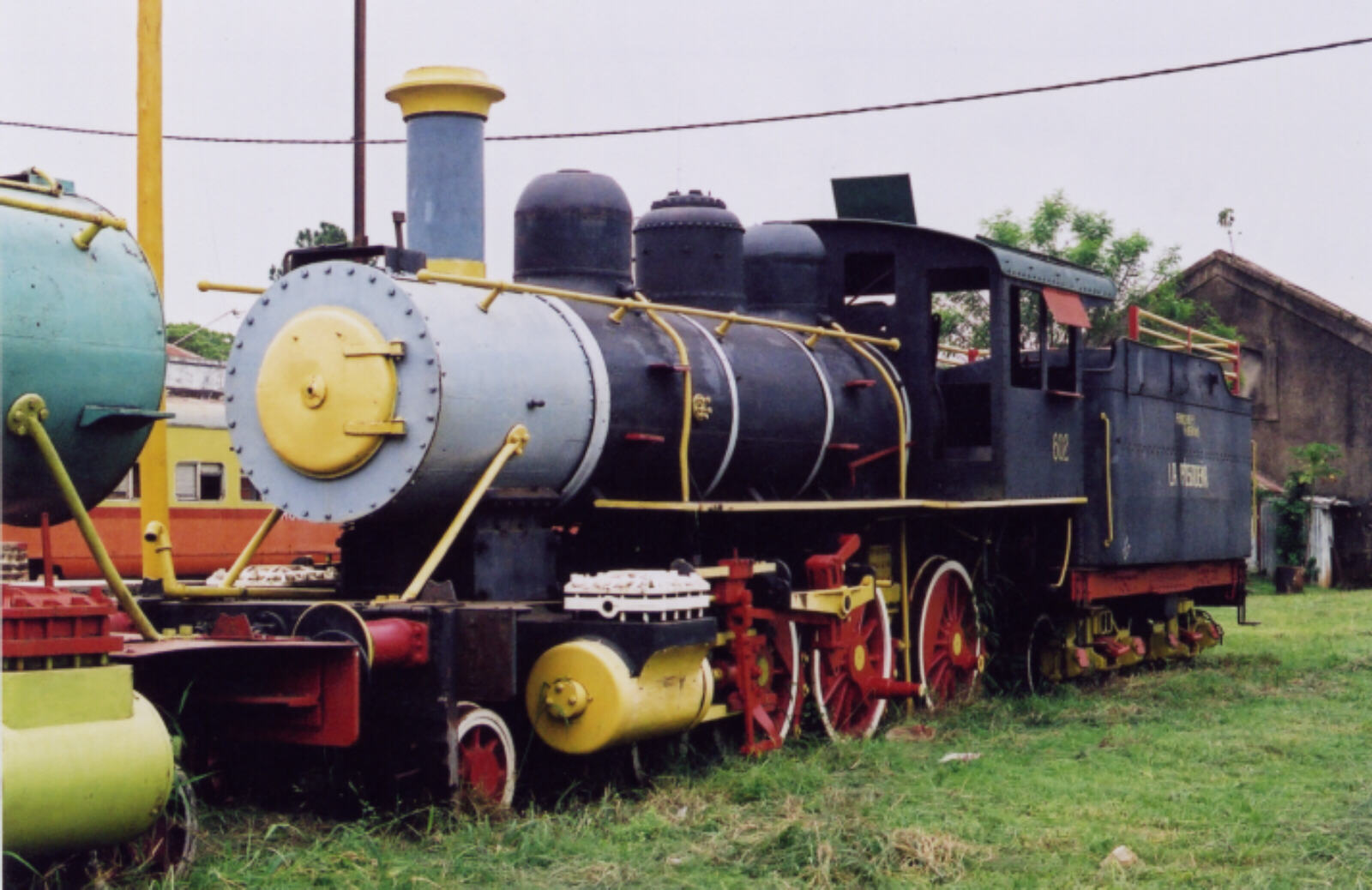
|
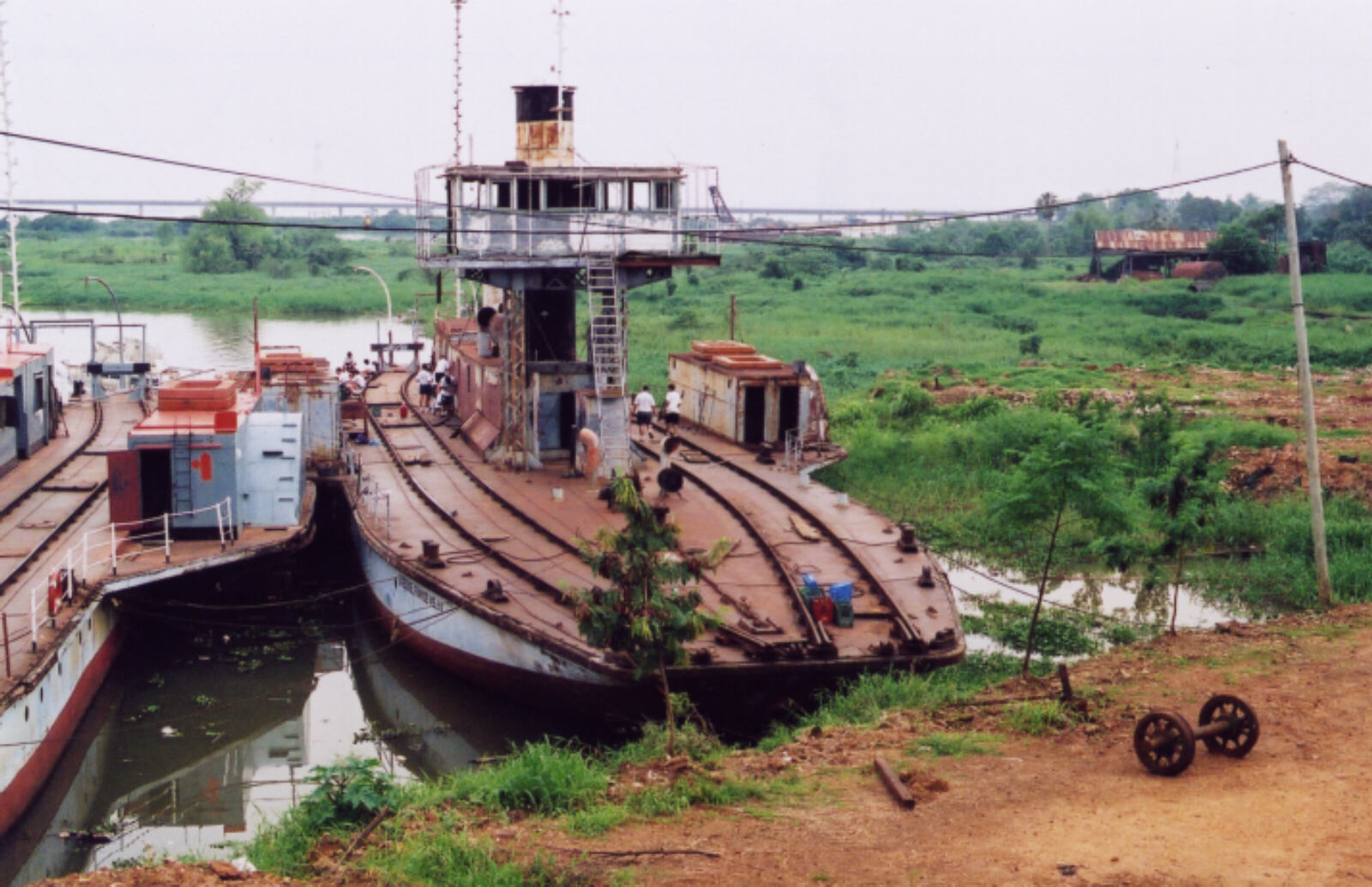
|
At 6pm we couldn't find anywhere to have a proper meal so we had a beer and sandwich at a café on the square before returning to the bus station for the overnight bus to Gualeguachu (pronounced Wally-wachoo) 800km/500 miles away near the Uruguayan border. The Express Singer line bus was one of the best we've been on - there was a huge amount of leg-room and we were upstairs in the front seats with a panoramic view. The only problem was that they had left the door open somewhere and the bus was full of mosquitoes, so there was a considerable delay while Sheila and another passenger refused to get on, and the driver had to go to a supermarket and get a can of insect spray and quickly spray the bus (then Sheila took it from him and sprayed more thoroughly), then a can of air freshener to hide the smell of bug spray. Eventually we got going and they even served up an airline-style hot meal.
Fri 25th Oct. We were due to arrive in Gualeguachu at 6am, plus a bit for the late start, but our bus really zoomed along, overtaking everything else, and didn't stop, so we were dozing nicely at 5am when the conductor came along and told us we're here! We scrambled off the bus and found ourselves in a 'motorway services' style café/bus station. The man serving in the café spoke excellent English and told us the bus across the border to Fray Bentos in Uruguay was due at 8am. At this point Sheila became a total wimp and insisted we got a taxi - this cost 65 pesos ($18, £13), not bad value for a 50km ride plus messing about with the border formalities. |
Fray Bentos, Uruguay
|
Fray Bentos is a sweet little town, with a pleasant park by the river. It was all very quiet and cool in the early morning sunshine as we waited for things to open up. By 10am there was still no sign of anyone in tourist information so we got a taxi to the main attraction, the Museum of the Industrial Revolution which is actually the former El Anglo Fray Bentos meat packing factory. You can only look round on a guided tour, but there was nobody else there so we had a personal tour and the English-speaking lady who took us round was very good. We strolled through the old complex of slaughterhouses, conveyor belts for carcasses, machinery sheds and so on.
|
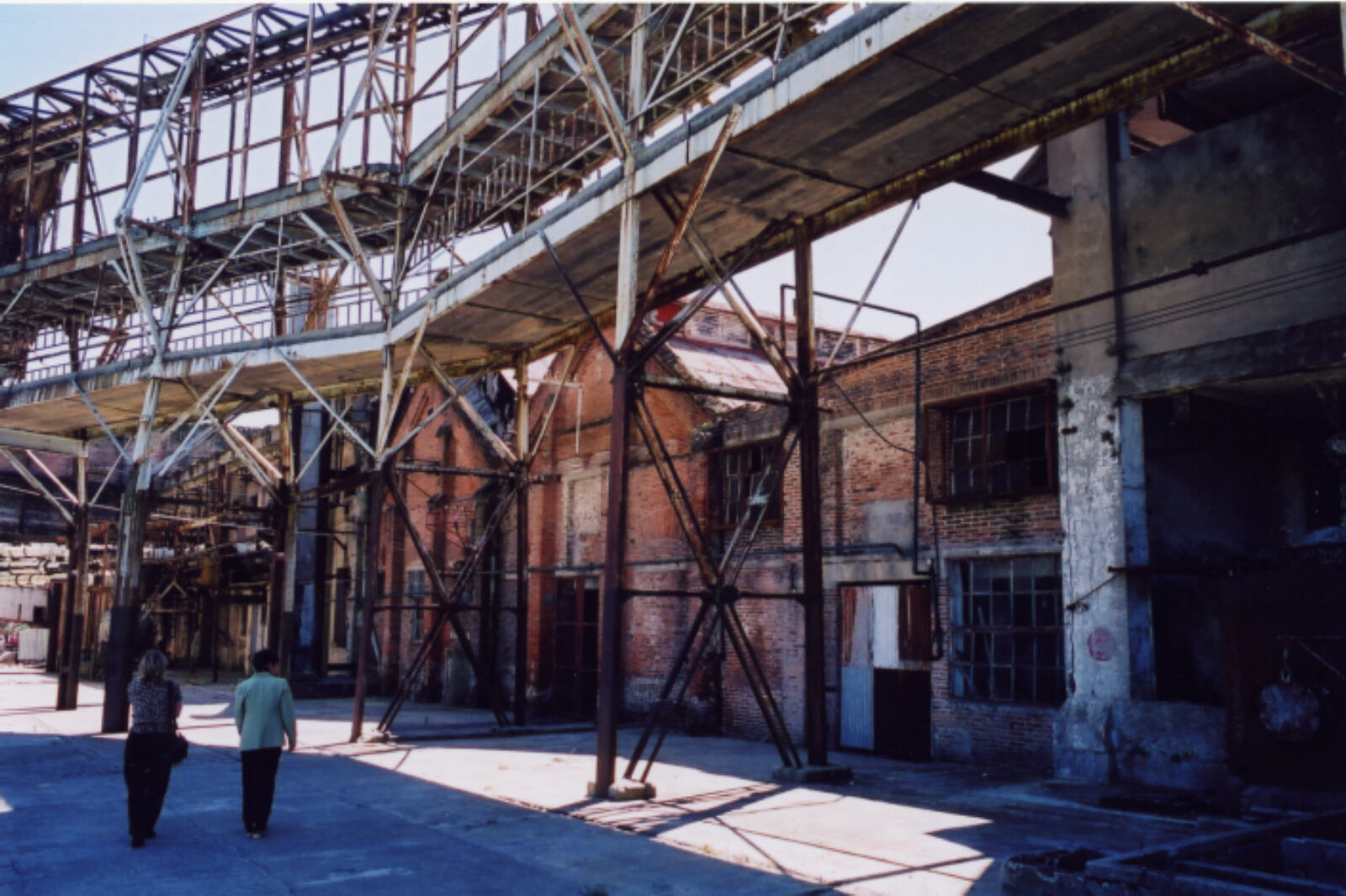
|
There was an engine room with three generations of huge engines powered respectively by steam, electricity and oil. |
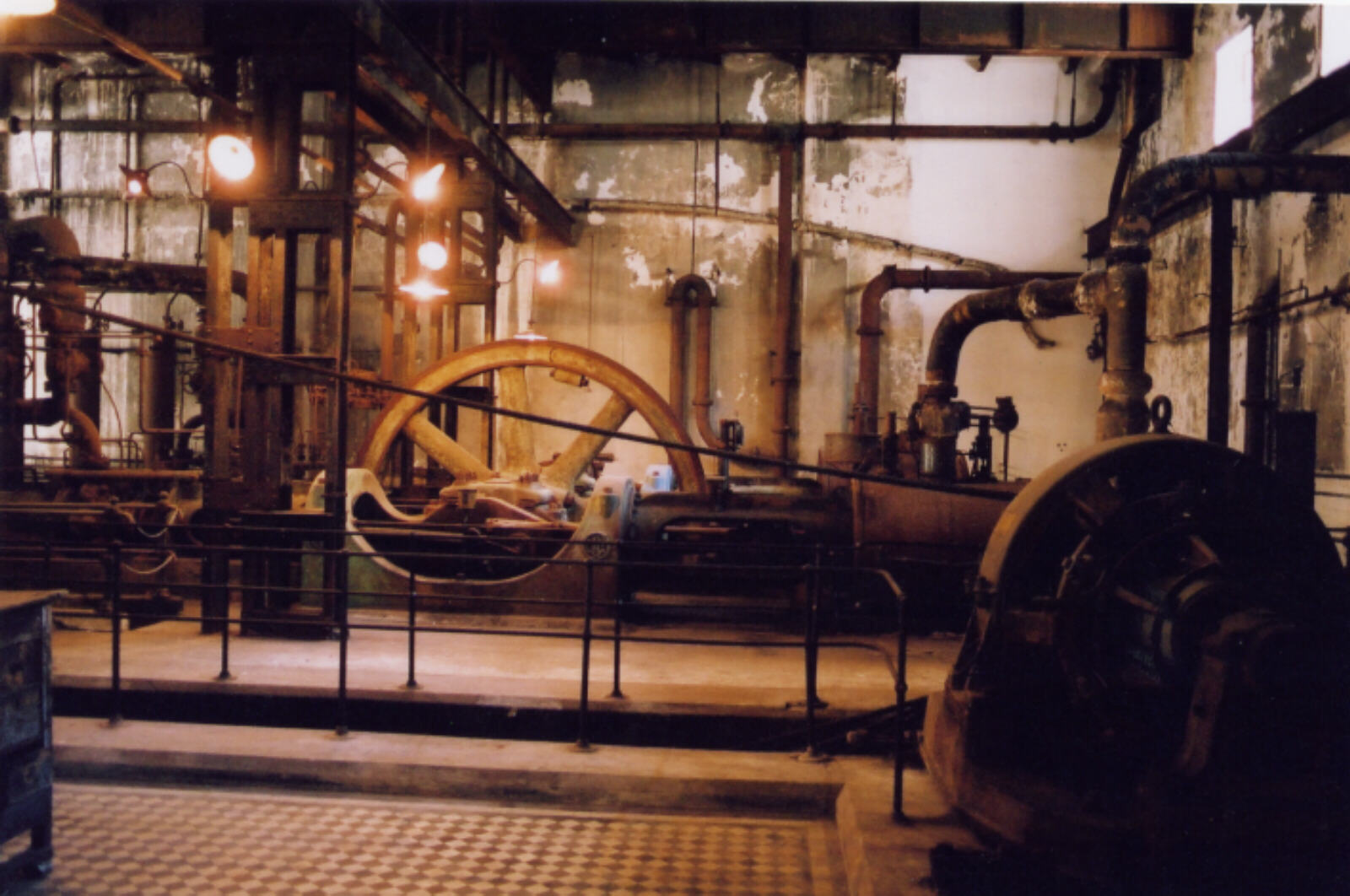
|
There was the big old electrical power station which was the first one in Uruguay, and a shed over the river with a former fire engine from the 1800s that had been turned into a stationary water pump, suspended over the river Uruguay. |
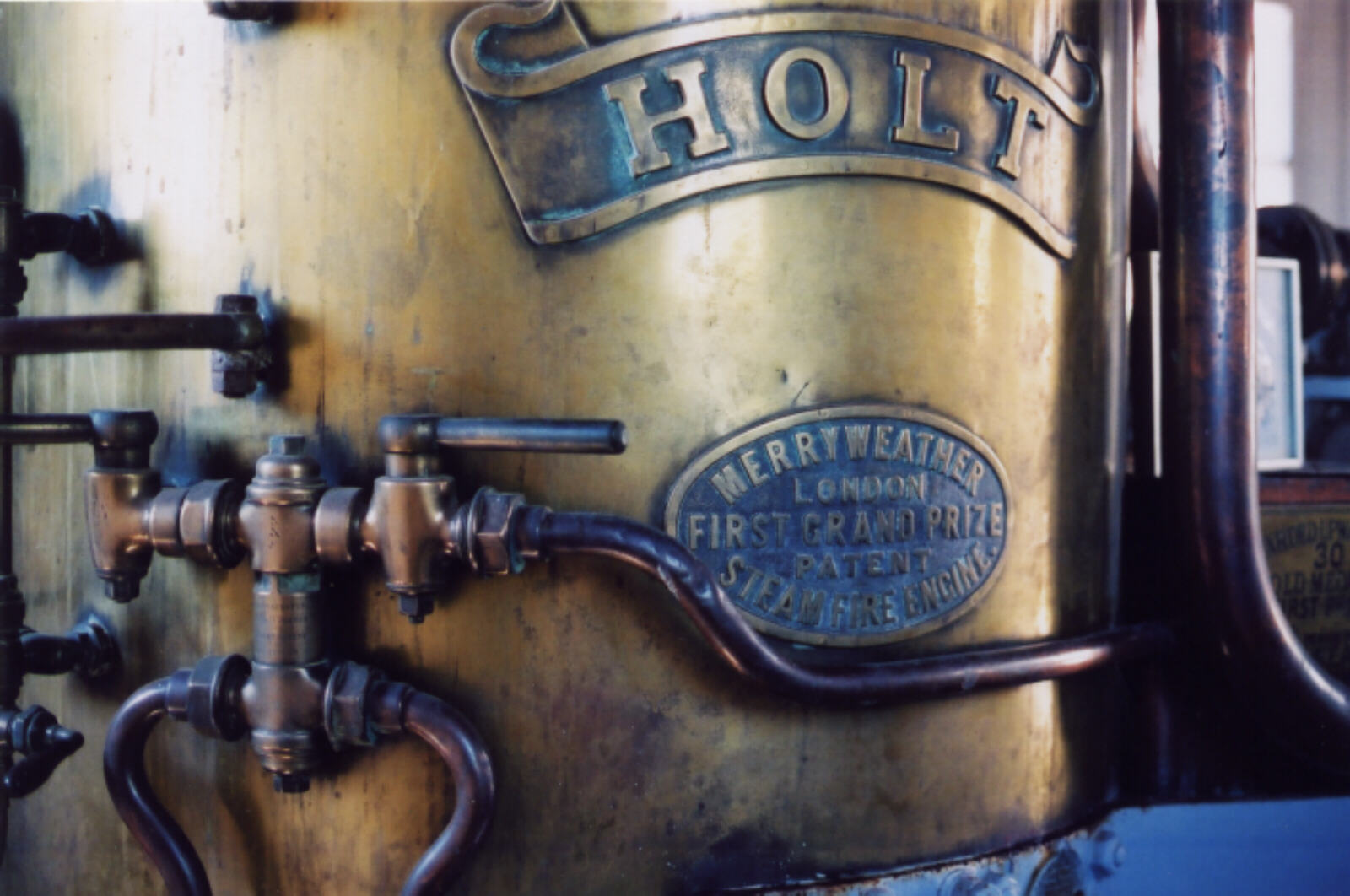
|
Then we went into the offices which were a time capsule from the 1920s with wonderful wooden desks and chairs, big old ledgers and ancient typewriters. The manager's desk had an old calculating machine and in the background are ledgers from the 1920s listing the number and weight of cattle processed each day. |
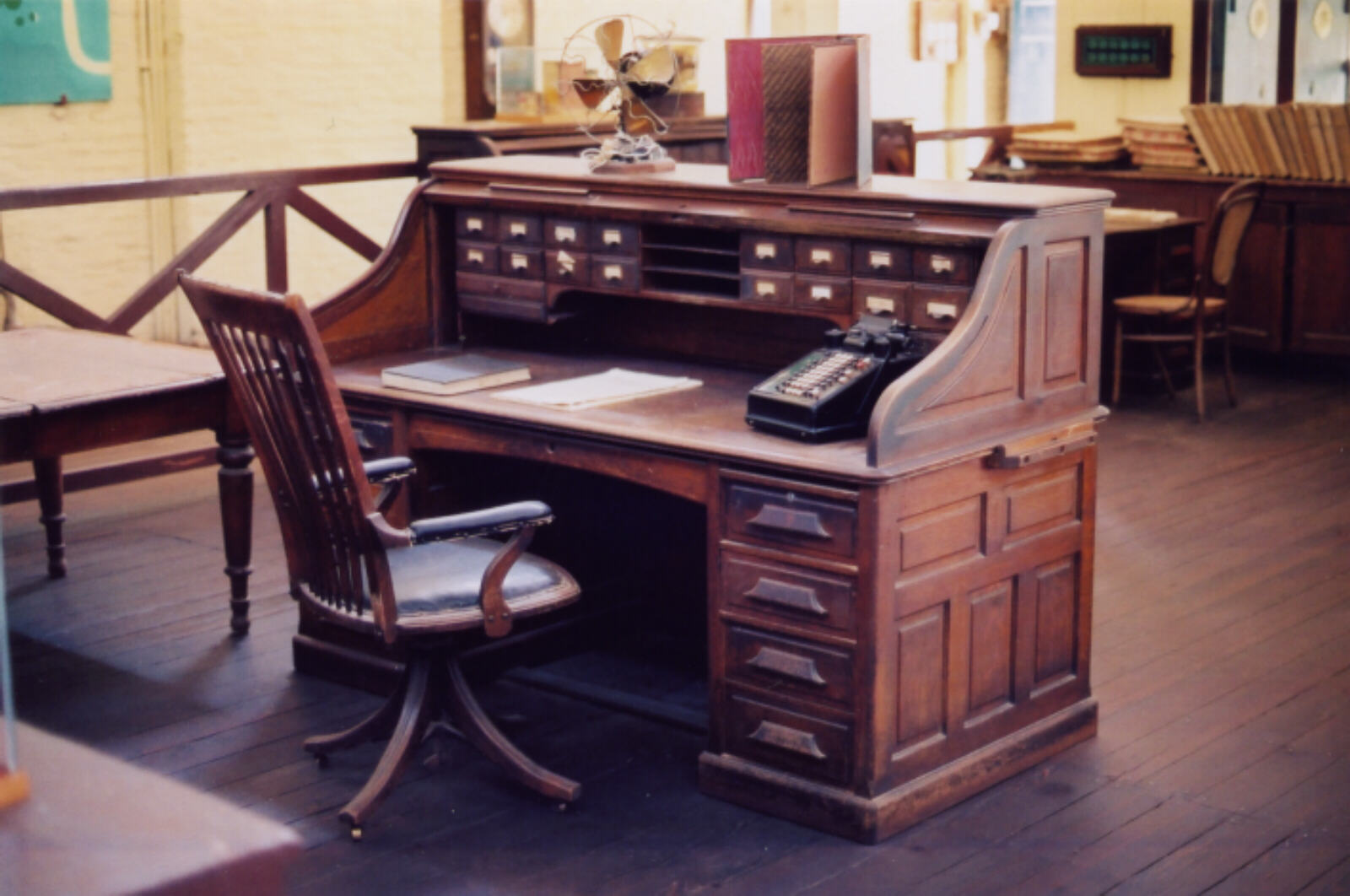
|
It was all fascinating. There were a surprising proportion of British people's names in the visitors book - clearly a lot of people who remember Fray Bentos corned beef from the 1950s and 60s feel the need to see where it came from!
There are a couple of direct buses a day to Colonia, our next destination, but we seemed to have missed them so we got a local bus for the half-hour ride to Mercedes then caught another one for the 2½-hour ride to Colonia. Again the local buses were very comfortable and none of the passengers brought any chickens on with them. |
Colonia, Uruguay
|
In the bus station at Colonia we happened to meet a very helpful man who spoke good English and he recommended La Mision Hotel, right in the centre of the historic old town. It was lovely, in an old house lovingly restored and beautifully decorated by a friendly Argentine couple, Juan and Mercedes, and we felt really at home there. We had a nice meal at Casa Grande restaurant round the corner and decided that we liked Colonia.
Sat 26th Oct. We have raced through 700 miles and some fascinating sights in the last three days so we decided to slow down and see Colonia at leisure. It is an historic old town and port on the River Plate, founded in 1680 and, on first impressions, not changed since. We had a very pleasant day strolling around the old town and the little harbour, and a truly excellent lunch at La Florida restaurant just outside the old town walls.
Looking down los Suspiros street, the River Plate flows by in the background. |
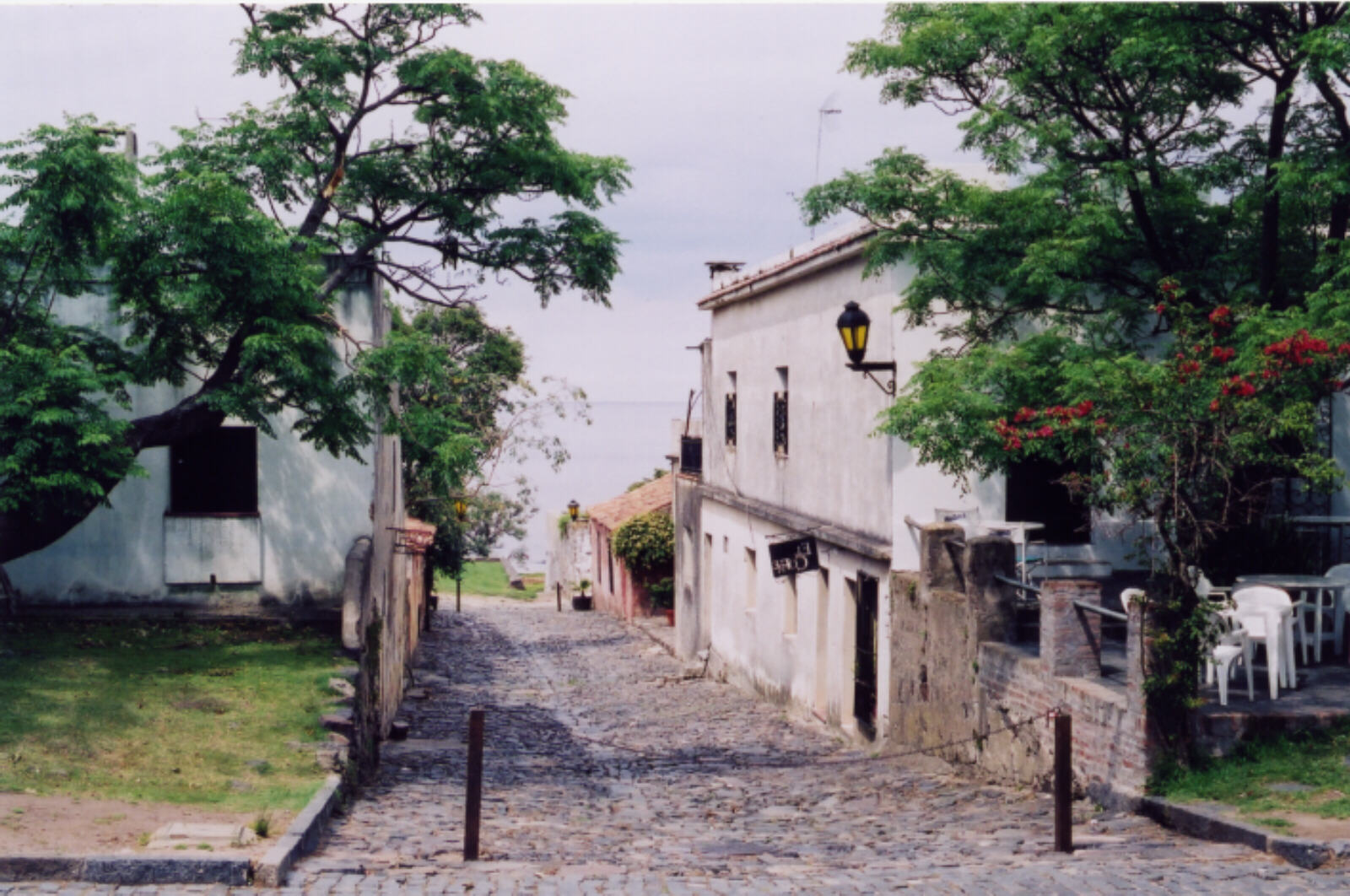
|
Vegetables are delivered by horse and cart to La Florida restaurant. |
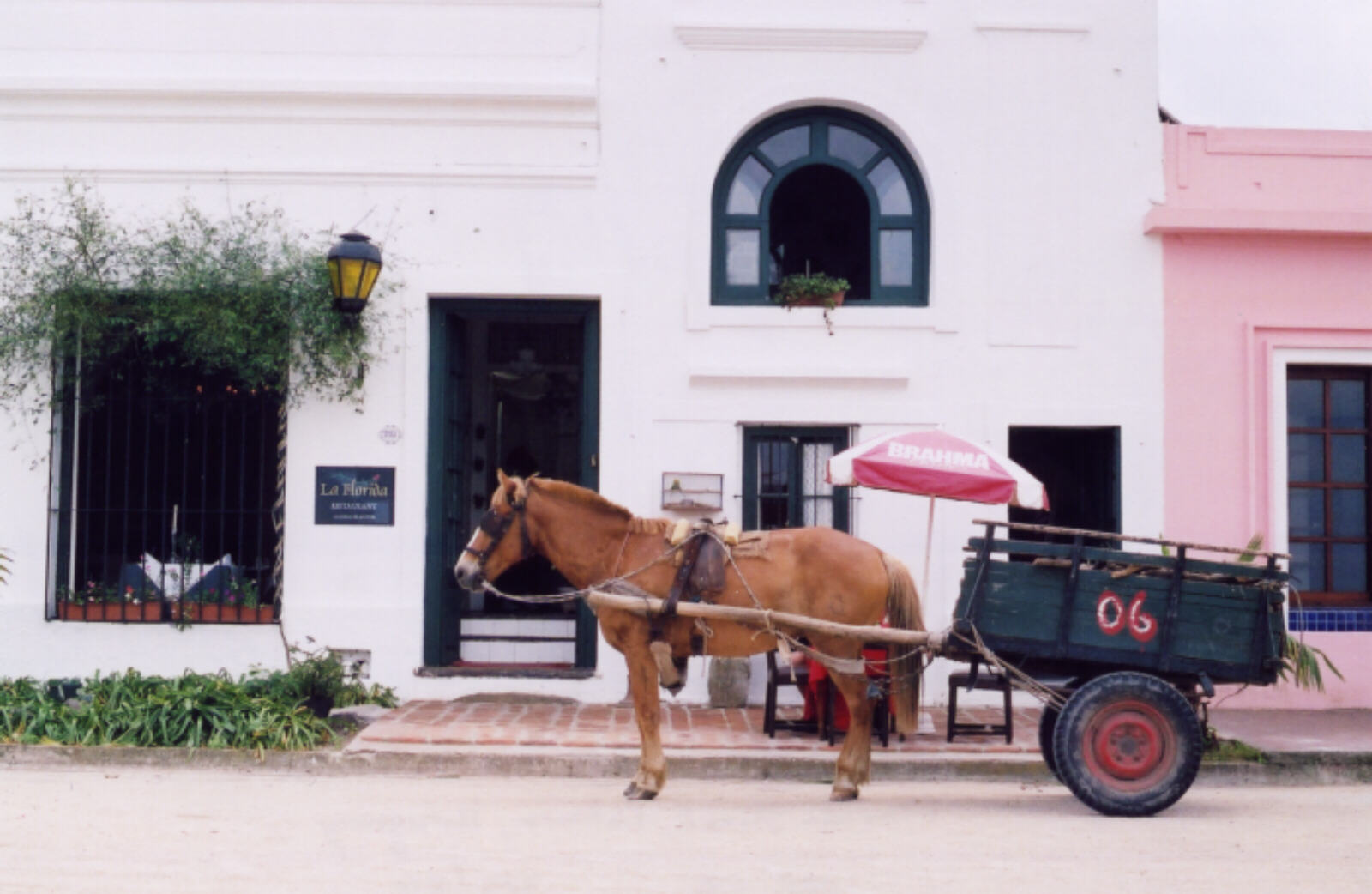
|
Another interesting restaurant has a table set in the car outside. |

|
Sun 27th Oct. We hired bicycles from Thrifty rent-a-car/scooter/bike and cycled up the riverside promenade to the old bull-ring at Real de San Carlos, which is a huge brick and iron construction outside Colonia. It was built in the early 1900s and operated for just two years before the President banned bullfighting and it closed down. As we were leaving, Sheila's bike developed a flat tyre but a kindly family in a house nearby brought out a pump and pumped it up again (the bikes had no accessories like pumps). However, a couple of hundred yards down the road it was flat again so we stopped at a hotel, where a very friendly teacher with a party of students who were staying there tried to mend it for us, and when that didn't work they phoned Thrifty, then practised their English on us while Thrifty brought out a replacement bike.
Back in Colonia we had a very nice Parilla (barbecue) late lunch/early dinner at the Madera Restaurant, sitting out in the sunshine with a view of the harbour. The most amazing old cars were driving around the streets - a 1940s Ford pickup was delivering firewood to another Parilla restaurant nearby. We finished off with a 'dulce de leche' ice cream from the parlour opposite the square in the new town. There are some wonderful old cars struggling round the streets in Uruguay. This one was parked in Real Street, Colonia .... |
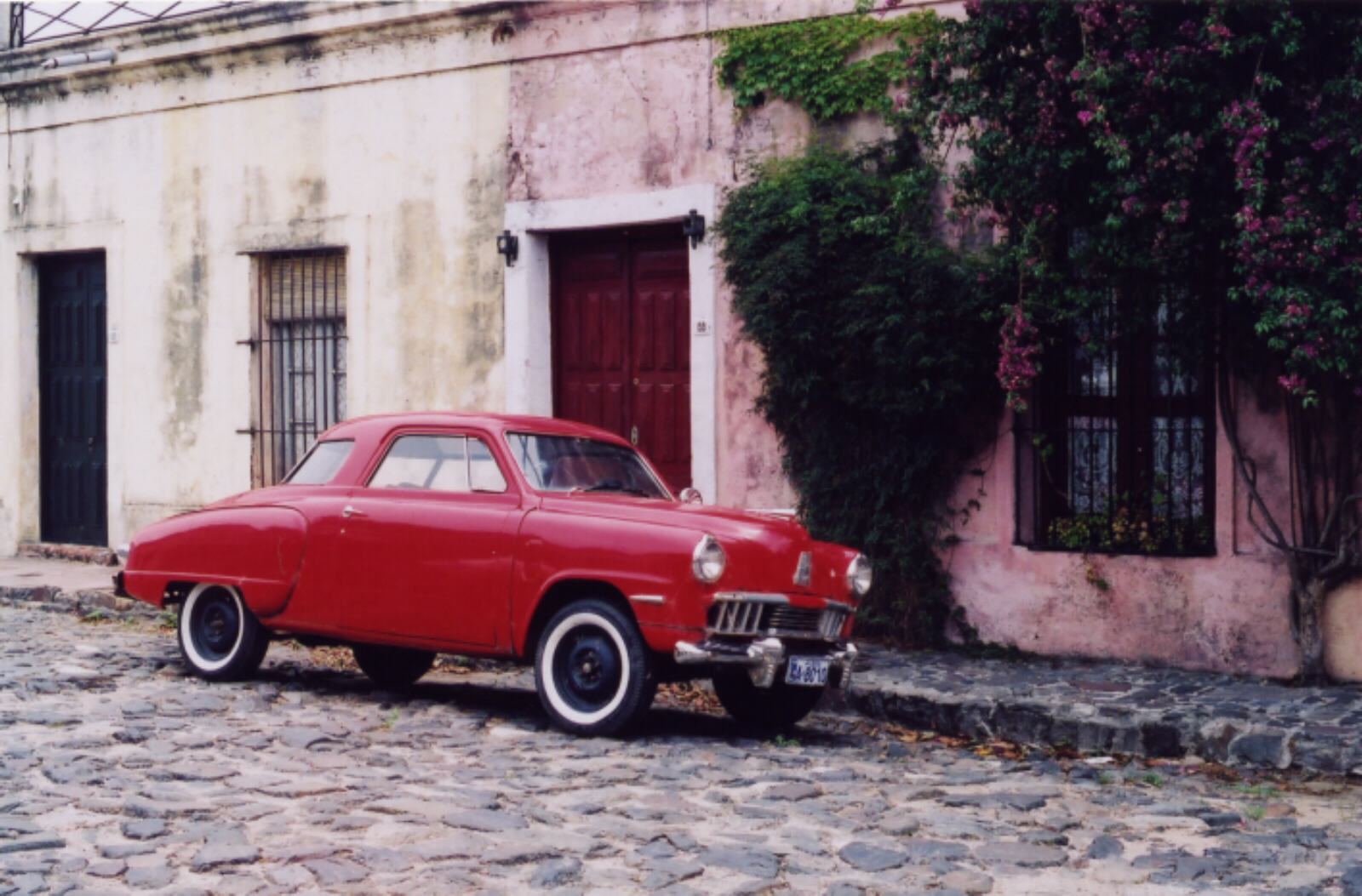
|
.... and this one was parked outside a house in Fray Bentos.
|
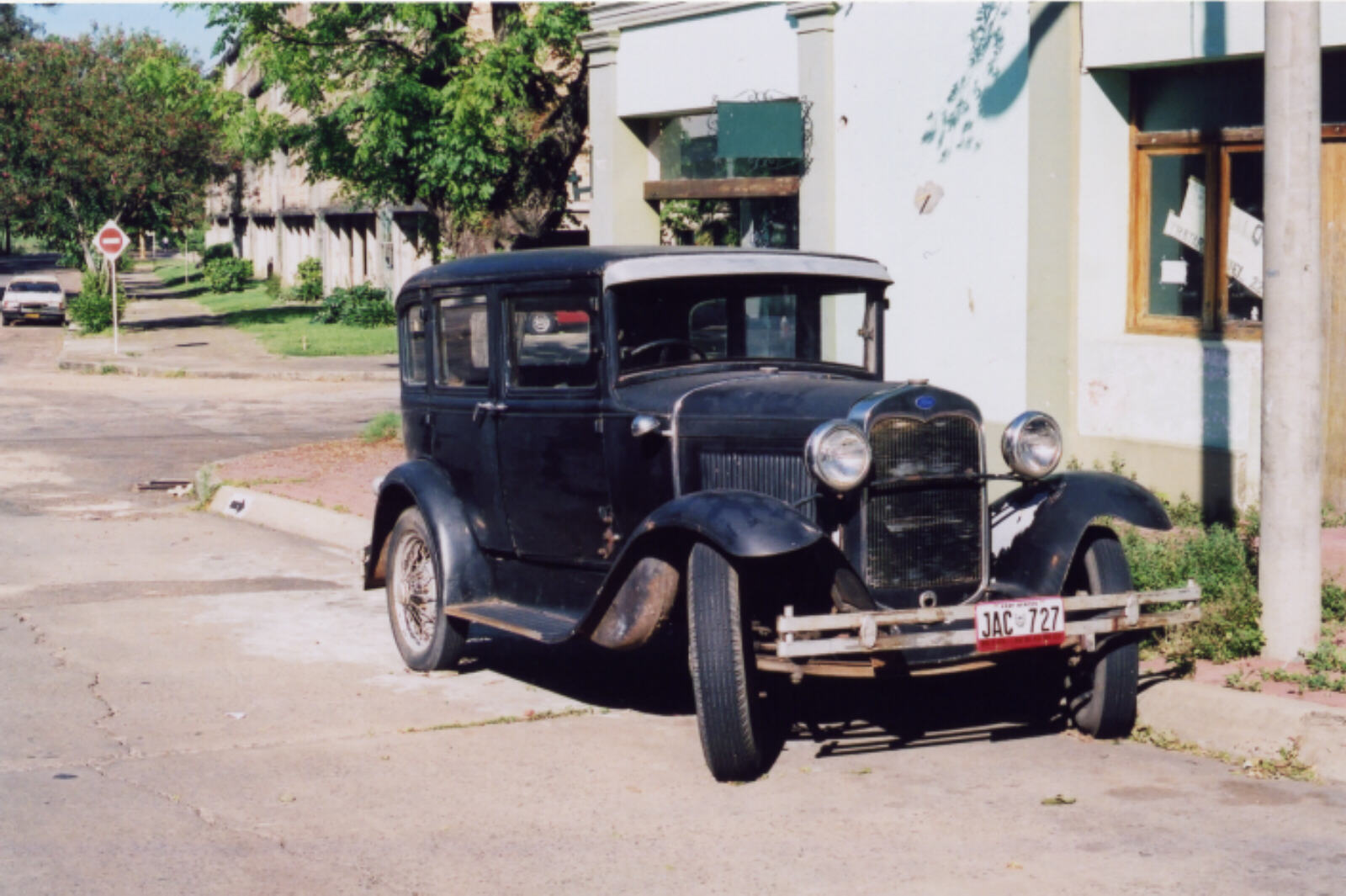
|
Mon 28th Oct. Today it rained for most of the day and the wind howled up the River Plate from the Atlantic and Colonia had a very damp Monday morning feel to it, so we spent the day having coffees in cafés and a wonderful long leisurely lunch at La Florida restaurant. |
Montevideo, Uruguay
|
Tues 29th Oct. The sun was out and the town was fresh and bright, but we were moving on. We caught the bus for the 3-hour journey to Montevideo ("I see a hill") and checked into the Crystal Palace hotel. This is in an excellent location on the main street in the central district and it was a bit of 4-star luxury. Montevideo has a nice compact centre and we walked down the main shopping street into the old town, through two or three leafy plazas. Although it was all very pleasant, we met an Australian couple who had come from Buenos Aires to visit Montevideo for a couple of days, and they said that the shops and the atmosphere in BA were so much more buzzing, and better value, so we have probably done it the right way round, leaving Buenos Aires till last. We had a couple of tasty chorizo sausage hot dogs for lunch from one of the street stalls that sit at every other crossroads, and for dinner we had a drink in a bar in the old town while we waited for the restaurants to open, then an excellent Italian meal at Panini's.
Wed 30th Oct. We went on a walking tour of Montevideo, through the new and old towns, looking at the shops and buildings. Most of the last-century buildings are big but rather ugly - the older, potentially more attractive ones in the old town are crumbling away and inhabited by squatters. We saw Government House in Plaza Independencia, formerly the residence of the Estevez family, built in 1873 in Italian Neoclassical style .... |
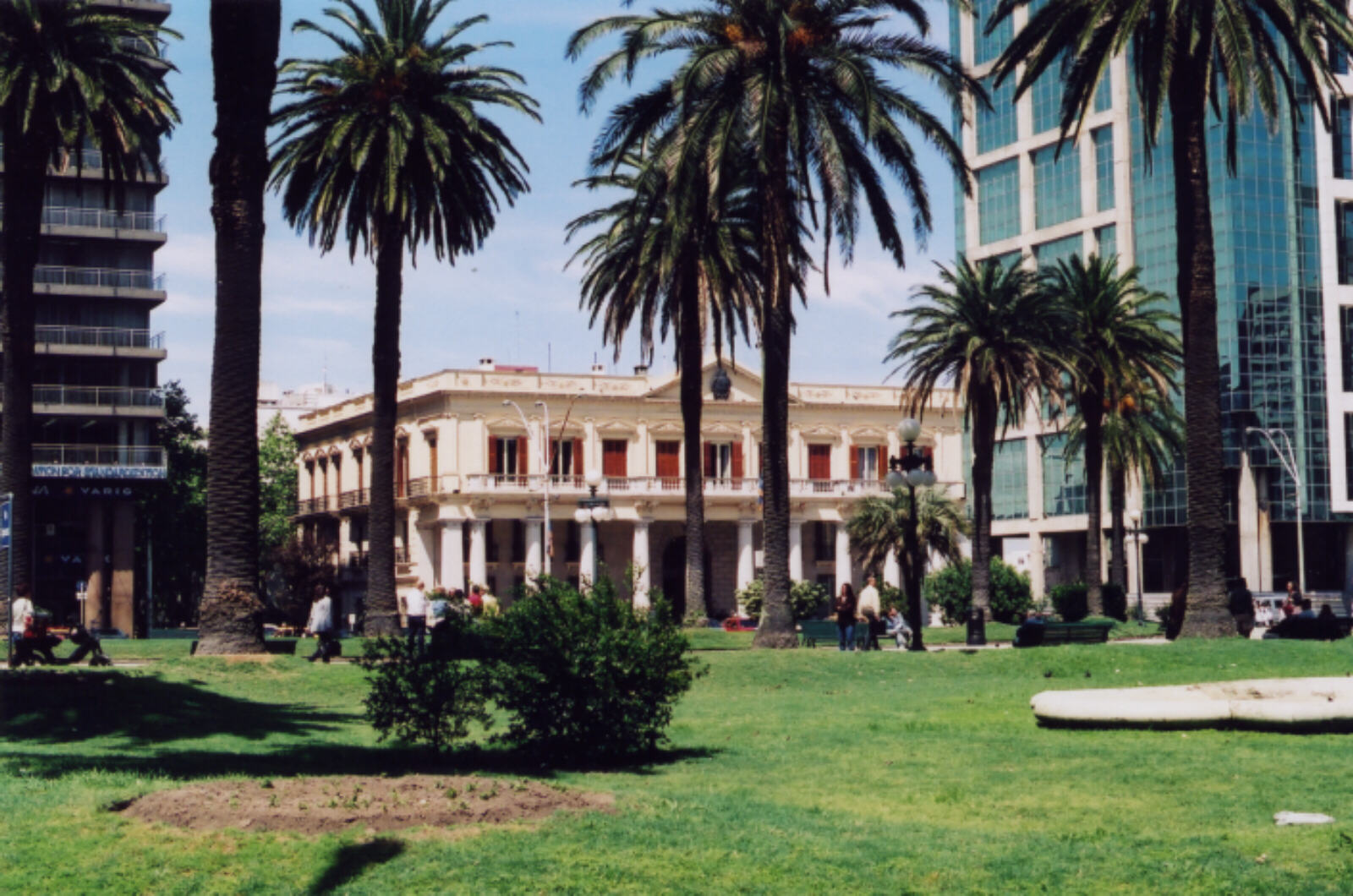
|
.... and an unusual skyscraper and the old railway station.
|
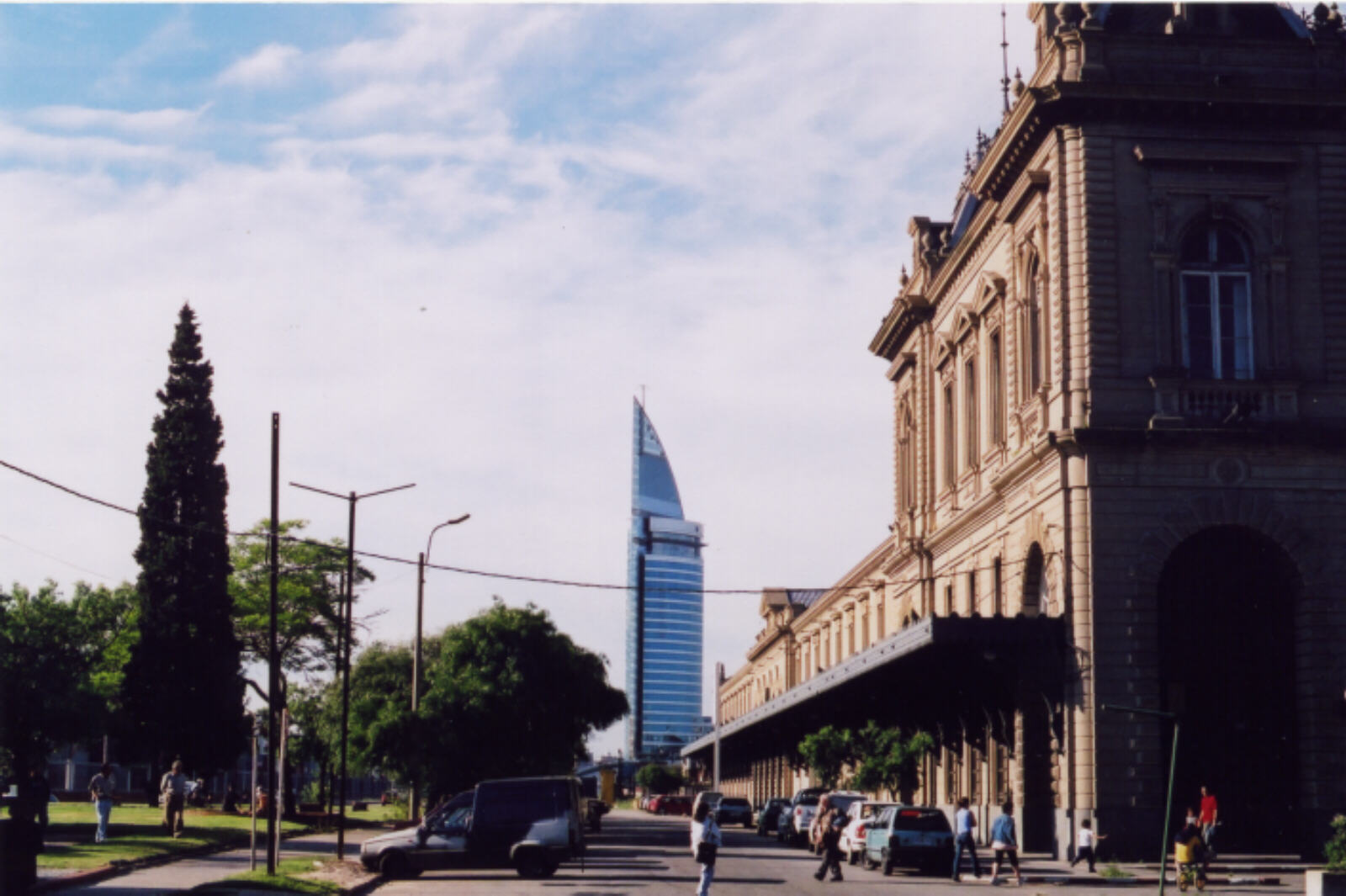
|
We ended up at the port market, which used to be the meat and veg market but is now entirely taken up with restaurants. Although it looks a bit touristy they are very good and most of the diners are local people. We settled for La Pradera and had a truly wonderful meal: starting with a huge chorizo sausage, then big red peppers coated in herbs, a tomato and onion salad, baked potatoes smothered in cream and roquefort sauce and finally a big, lean, tasty piece of steak. Including wine and beer, great value for $20 including tip. We sunbathed on the harbour breakwater watching the fishermen for a while then strolled back into town. After such a great lunch we didn't feel like a full dinner, so we had an eclectic evening meal; starting on the 25th floor bar of the Radisson Hotel on Independence Square we watched the sun set over the old town with a couple of glasses of wine and plates of peanuts; then we had a couple of tasty hot dogs from the gleaming chrome street stands - they are trailers so we thought they moved around until we noticed that all their tyres were flat. We finished with more dulce de leche ice cream from the ice cream shop opposite the hotel. |
Buenos Aires, Argentina
|
Thurs 31st Oct. We caught the 11:30 boat for the two and three-quarter hour ride across the River Plate to Buenos Aires. The departure lounge at the port was more like an airport, and the price ($45 each) was more like airline prices, but it was fast and smooth and a very easy way to cross back into Argentina. We had been recommended the Hotel de la Paix, which was very good and in a good central location.
Buenos Aires is big! Without further ado we set off to explore, but got no further than the next corner where we found a Museo de Jamon (Museum of Ham) restaurant, with great haunches of cured ham hanging from the ceiling. We had a wonderful lunch of ham and cheese followed by steaks washed down with a nice red wine, and by the time we set off to shop it was 5pm! We spent the rest of the evening strolling along Florida, one of the main pedestrianised shopping streets, and finished up with beer and peanuts at a café on Avenue 9th July.
Fri 1st Nov. A day of shopping and sightseeing in Buenos Aires. Sheila had the complete pampering experience with hairdo and manicure at a very trendy salon in the centre of town. We saw the obelisk on Avenue 9th July, supposedly the widest street in the world, or so they claim .... |
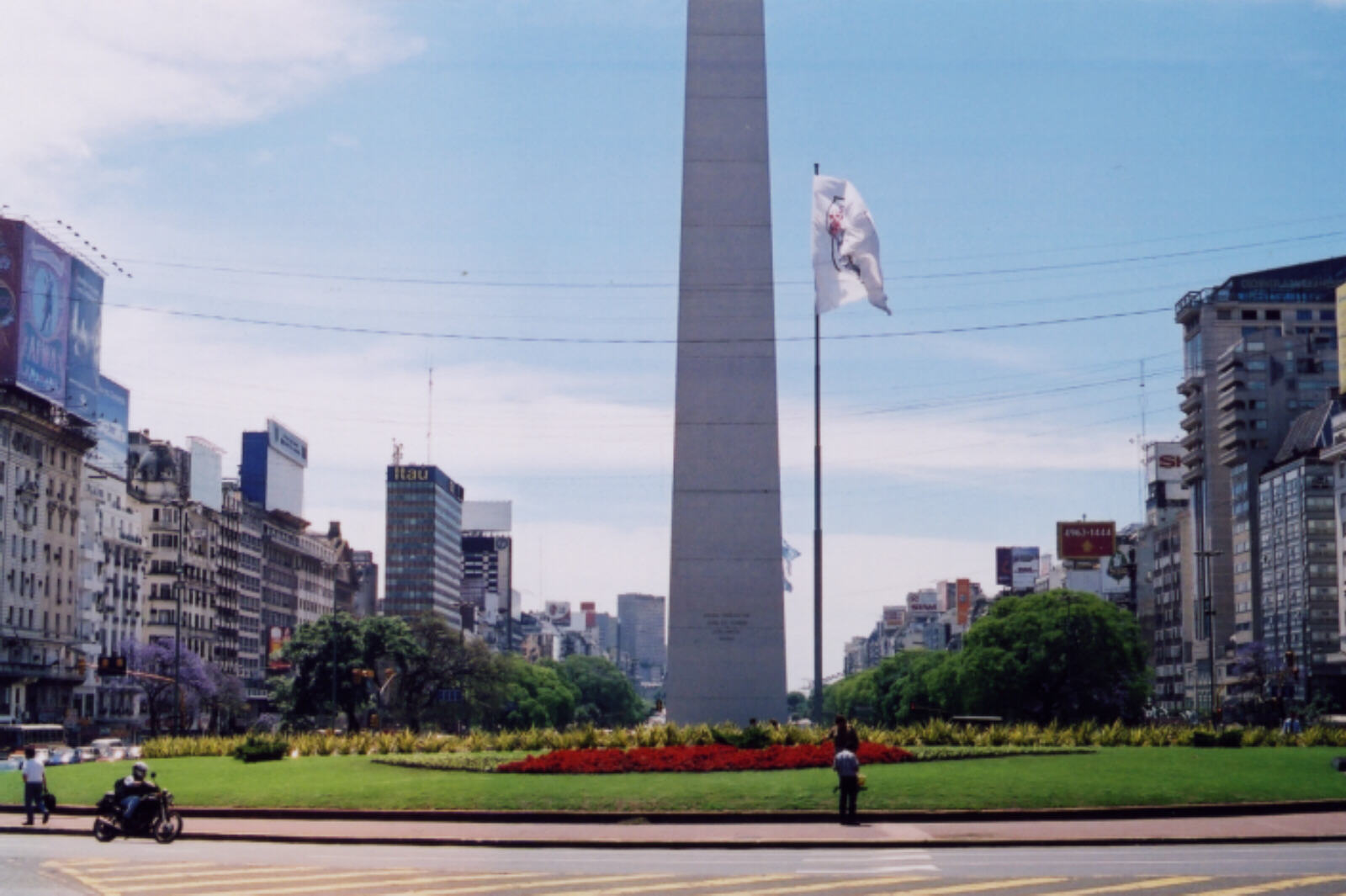
|
.... and we saw Casa Rosada on Plaze de Mayo, the Presidential Palace with Evita's balcony.
|
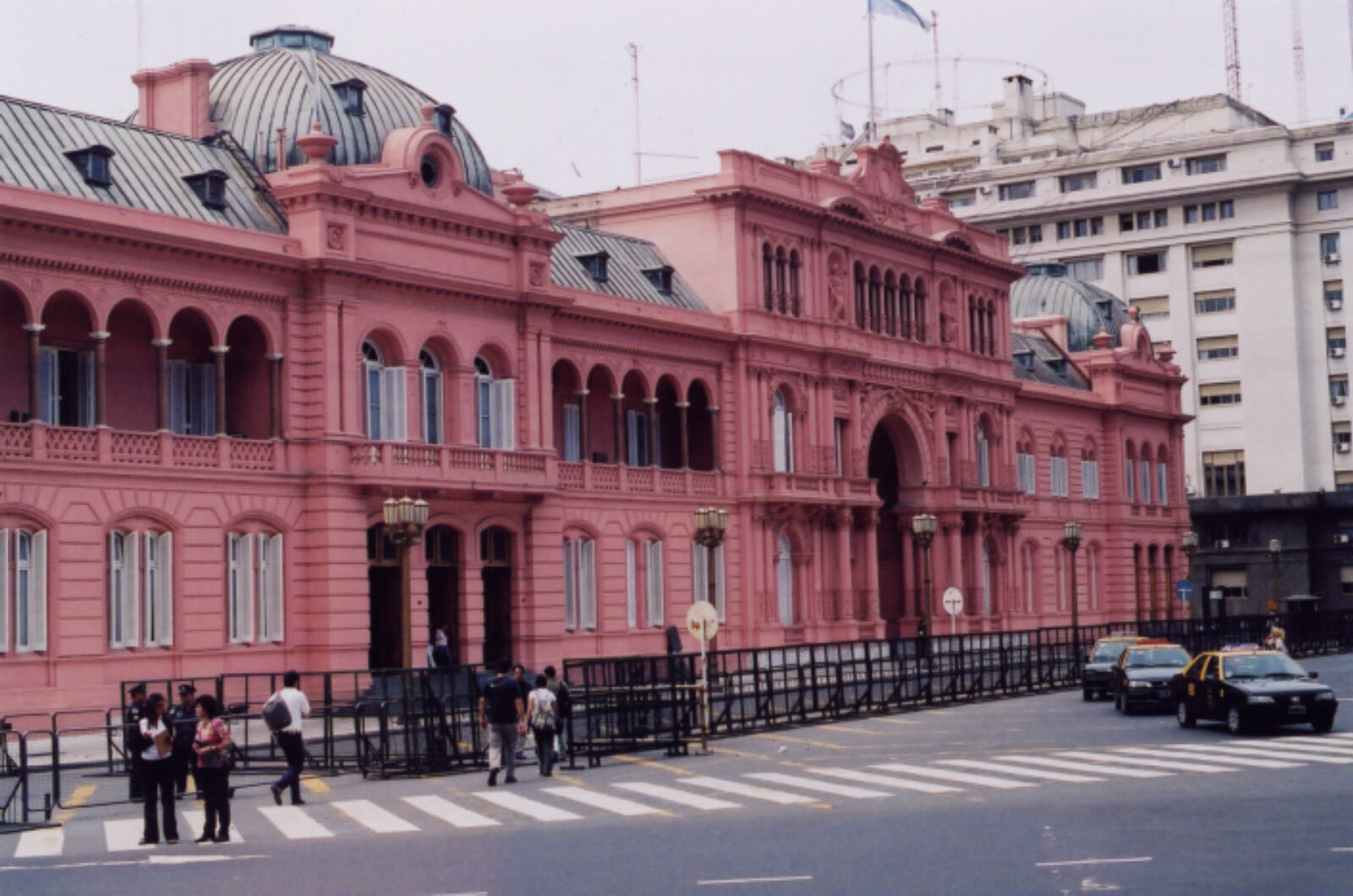
|
For dinner we went to the most amazing buffet at Grant's Restaurant in Junin Street. There was an absolutely huge array of dishes, dozens of them, hot and cold, as well as four chefs cooking up more meals and barbecues to order, and all of it really tasty - or at least everything we tried, we could do no more than scratch the surface. All this, as much as you can manage to eat, for 11 pesos ($3, £2). And it's even cheaper at lunchtimes!
Sat 2nd Nov. Another busy day in Buenos Aires. We got a taxi to La Boca and strolled through Caminito street with its bustling street market, taking pictures of the multi-coloured painted houses. |
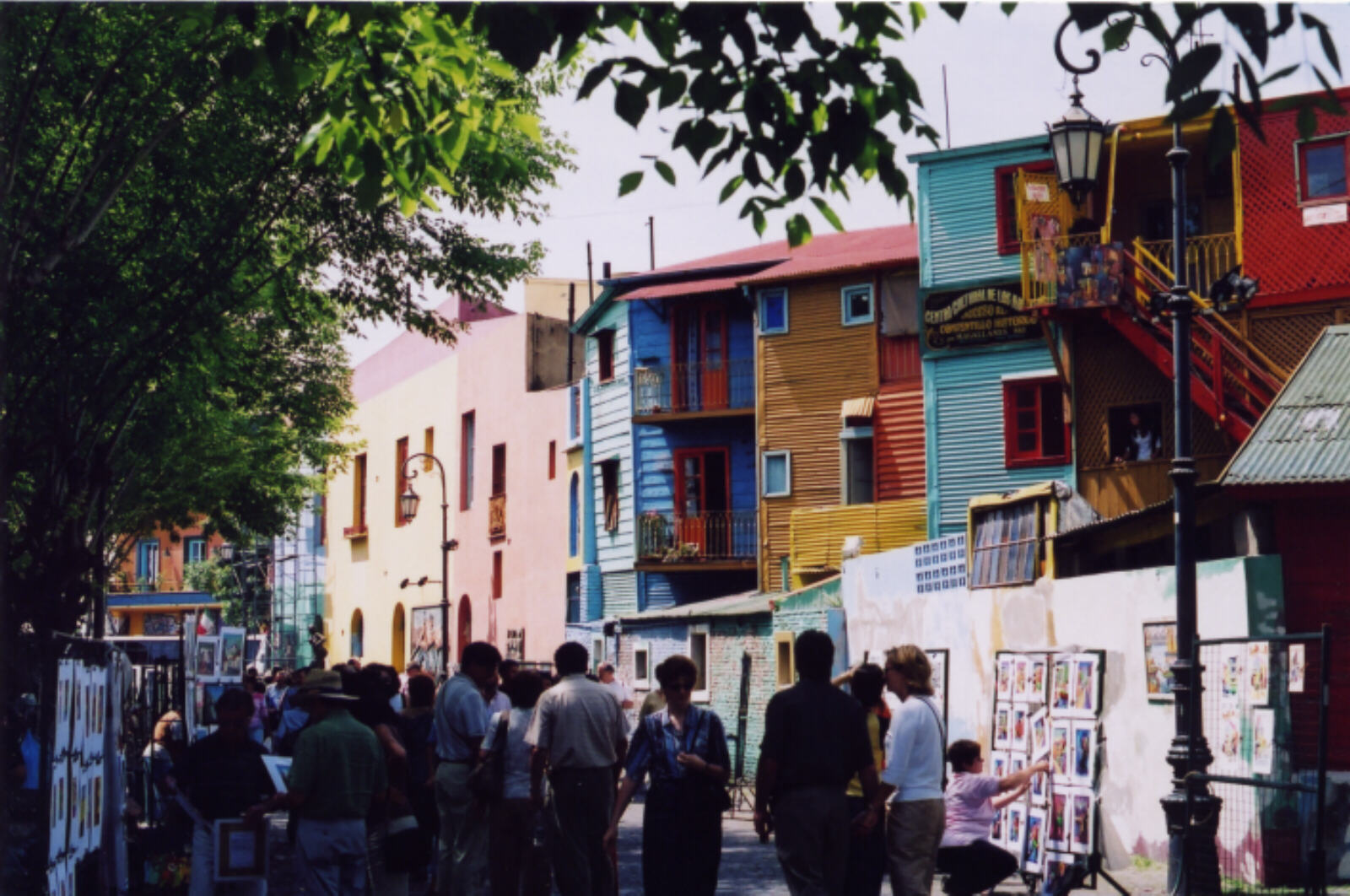
|
There were some unusual characters in Magallanes street in La Boca.
|
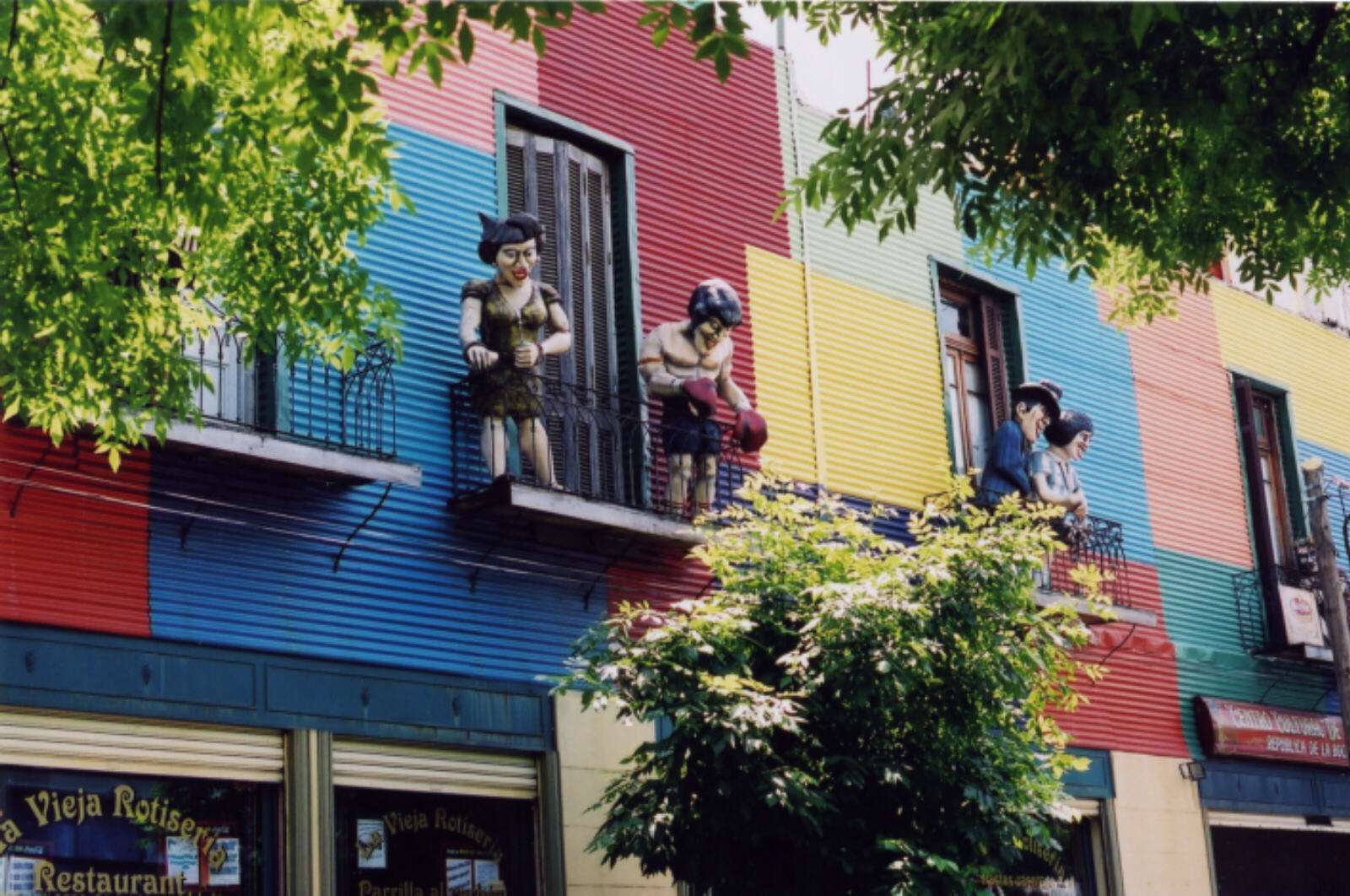
|
Then we got the bus back to Plaza Mayo and took pictures of the colourful Jacaranda trees in the sunshine. We went by metro to Plaza Once, where we found the shops were very busy but rather down-market, and the square was occupied by rather sad food queues, segregated into men's and women's, waiting for some nuns to arrive and start doling out food. We had a look at Abasto, one of the big Malls, bought some wine and teas at a fascinating deli run by a Polish lady, and had an ice cream. Then by taxi to the more up-market Alto Palermo mall and the nearby clothes shops, then bus number 111 back to the centre and walked along Florida and Lavalle pedestrian streets. There was lots of street entertainment - tango dancers, spray can paint artists and finger paint artists, painted mime 'robot men' and a Latino band with pan pipes. Sheila had a quick fry in a Solarium. We had dinner at La Estancia on Lavalle Street, wonderful tasty, juicy, gigantic steaks.
Sun 3rd Nov. We went to the Sunday market at San Telmo district, which was bustling and lively with street musicians and mimes, but most of the stalls had rather overpriced 'antiques' and bric-a-brac for tourists. We walked back to the centre, browsed around those shops that were open, then were just in time for another buffet lunch at Grants. After a bit more strolling round the shops and malls we went to see a spectacular tango show at the Tanguera National Theatre.
Mon 4th Nov. We had a last look at the shops, yet another hairdo, a final ice cream, and we flew back to the UK. |
If you would like to see more of our travels just click the map.

|